AubsUK is a fork of EGZUMER for our beloved Quansheng K5(8)/K6(buy link) where some interesting changes have been made:
- The two scan lists have been replaced by 10 of them (0-9).
- The display no longer shows on the right which scan list the channels belong to.
- The currently scanning list is now shown at the top of the screen.
- Enabling/Disabling a scan list is as simple as pressing the list number.
- Channels can be excluded from the lists.
- Channels can be temporarily excluded from a list by pressing *, and this change will persist until the next reboot of the radio.
- It is possible to automatically start scanning when the radio powers on.
- All changes can be made from CHIRP.
- When a factory reset is performed, only one channel will be created instead of five.
If you are new to the world of ham radio, I recommend this previous article where the basics are explained.
In this article, we will first explain all the functions common with EGZUMER , and then the specific functions of this particular firmware.
Common functions:
- Reflashing
- Spectrum analyzer
- Scan frequency range function
- Battery calibration
- Functions
- Buttons and functions
- Unlocking frequencies
- DTMF calls
- Frequency scanner
- Scrambling
- Remote kill
- CHIRP
Specific functions:
Other:
Reflashing:
Before starting, we need to install
Mono
on Wine-Linux and then back up the configuration and calibration files as indicated in
this previous article.
It is also recommended to save the current radio configuration, as this will be useful later to load the channels into the new firmware. We save it twice, in both CHIRP and CSV formats, because if there are issues loading, the CSV file can be edited in order to alter or remove the problematic fields.
To create the backup, just follow these steps in
CHIRP
:
Radio -> Download from radioFile -> Save As ...File -> Export to CSV ...
We can now proceed with the reflashing by following the steps in this previous article , obviously selecting the firmware file corresponding to AubsUK.
From the AubsUK GitHub , they recommend performing a reset once the radio is reflashed:
Perform a factory reset (hold PTT + SIDE BUTTON 1 while turning on the radio, after 'RELEASE ALL KEYS' navigate to Menu 68 Reset then select ALL)
to clear some EEPROM locations that other firmware configures slightly differently
You can see the procedure in this video:
Spectrum Analyzer:
You can consult a quick guide on EGZUMER’s GitHub or download the PDF guide .
To access the spectrum analyzer, press: F+5(NOAA). The display should look something like this: 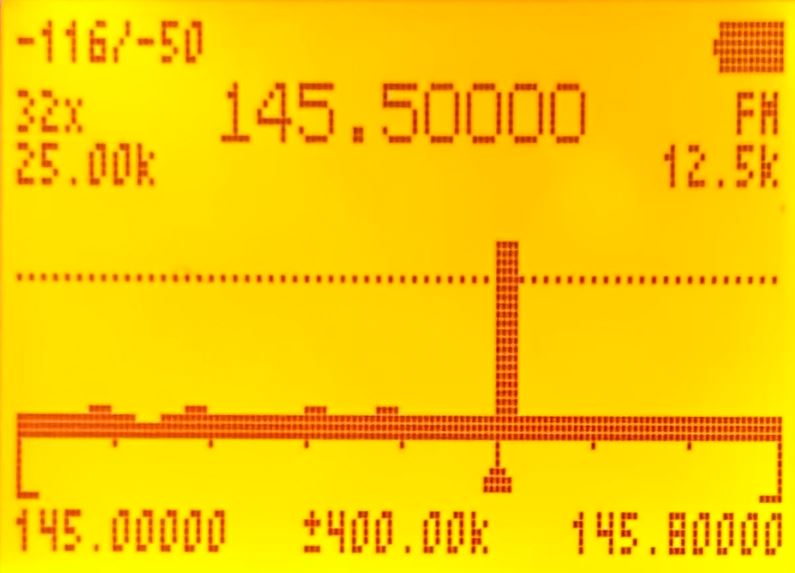
To make it easier to understand, here is a table where each row represents a line of information on the display. Each parameter is accompanied by an image from the previous example:
| First display column | Display | Second display column | Display | Third display column | Display |
|---|---|---|---|---|---|
Y-axis zoom: Max/current value. 3(VFO/MR)/9(Call) |
 |
Battery | |||
Number of channels to scan: How many channels (with the specified bandwidth) should be monitored starting from the initial frequency. 4(FC) |
Frequency with the strongest detected signal in that range |  |
Modulation type. 0(FM) |
||
Bandwidth per channel. 1(Band)/7(VOX) |
 |
Channel analysis bandwidth; depending on the signal emission, one bandwidth may perform better than another. 6(H/M/L) |
 |
||
Squelch line. *(Scan)/F(#) |
 |
Squelch line |  |
Squelch line |  |
| Spectrum: The bottom triangle shows the frequency of highest intensity, which is also displayed numerically at the top | 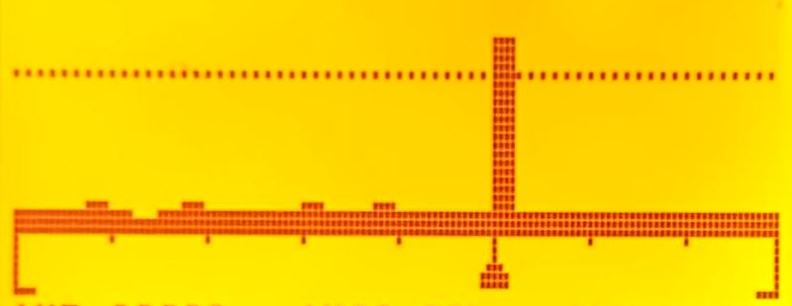 |
Spectrum |  |
Spectrum |  |
Initial frequency. 5(NOAA) |
 |
Scroll shift: How much to shift the frequency range start when pressing the Up(B)/Down(C) arrows. 2(A/B)/8(R) |
 |
Final frequency |  |
NOTE: If the squelch is exceeded, it only shows in real time the status of that frequency (145.500 in the screenshot); the rest stop being monitored in real time.
- In the example, we see 32 channels being monitored, each 25kHz wide: 32*25 = 800kHz.
- The start frequency is 145.00000, so the end frequency is 145.00000+800 = 145.80000kHz.
- Pressing the
Up(B)/Down(C)arrows moves the spectrum view by 400.00kHz. For example, pressingUp(B)shifts the start frequency to 145.40000, making the end frequency: 145.40000+800=146.20000kHz. - Y-axis zoom is set to -50, and channels are being analyzed using 12.5kHz bandwidth — the optimal bandwidth depends on the signal’s characteristics.
In addition to the functions above, more are accessible via these buttons:
| Button | Function |
|---|---|
5(NOAA) |
Enter the start frequency. Use * for decimal point, then M(A) to confirm. |
SideKey1 |
Exclude the current frequency from scanning, moving to the next strongest signal. |
SideKey2 |
Toggle backlight on/off. |
PTT |
Switch to detailed monitoring. |
Detailed Monitoring: To access this mode, press PTT.
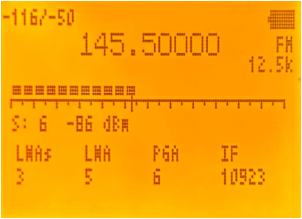
In this example, we see a level 6 signal equivalent to -86dBm, barely exceeding the squelch threshold.
In this menu, you can also make adjustments:
| Button | Function |
|---|---|
Up arrow (B) |
Increase the current frequency. |
Down arrow (C) |
Decrease the current frequency. |
3(VFO/MR)/9(Call) |
Y-axis zoom: Max/current (not useful in this view). |
5(NOAA) |
Enter frequency manually, * for decimal, then M(A) to confirm. |
6(H/M/L) |
Set channel analysis bandwidth. |
*(Scan)/F(#) |
Adjust squelch. |
0(FM) |
Change modulation type. |
SideKey1 |
Open squelch. |
SideKey2 |
Toggle backlight. |
Exit(D) |
Return to normal spectrum analyzer view. |
To access the parameters below, press M(A) and navigate using Up(B)/Down(C):
| Parameter | Function |
|---|---|
| LNAs | Low Noise Amplifier (Short): Amplifies signal with minimal added noise, details below(LNA: Low Noise Amplifier). |
| LNA | Low Noise Amplifier: Amplifies signal with minimal added noise, details below(LNA: Low Noise Amplifier). |
| PGA | Programmable Gain Amplifier: Amplifies signal post-LNA, after mixing and filtering, details below(IF: Image rejection architecture). |
| IF | According to the
datasheet
, IF is the combination of Filter+VGA(PGA)+ADC, but AubsUK firmware refers only to the filter, details below(Incoming Signal Diagram). |
Below is the general signal processing diagram with elements adjustable in AubsUK (LNA/IF/PGA).
Incoming Signal Diagram:
According to the
BK4819 datasheet
, the signal enters via the antenna, passes through the LNA (amplified), then through the MIXER, enters the IF where it is filtered, further amplified via VGA(PGA), and finally digitized.
Bear in mind the datasheet uses IF for the entire chain Filter+VGA(PGA)+ADC, while AubsUK firmware separates them (IF = Filter, VGA = PGA).
These are labeled in red in the diagram.
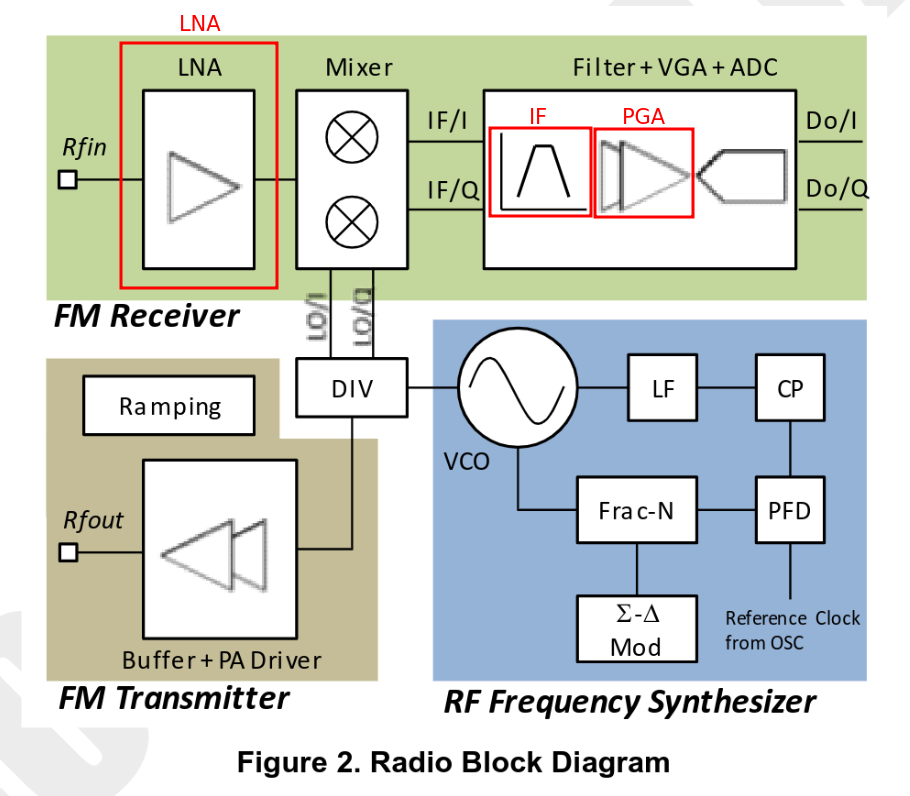
LNA: Low Noise Amplifier
Weak signals need amplification with minimal added noise. When amplifying, we increase both the signal and the existing noise, plus some from the amplifier circuit. 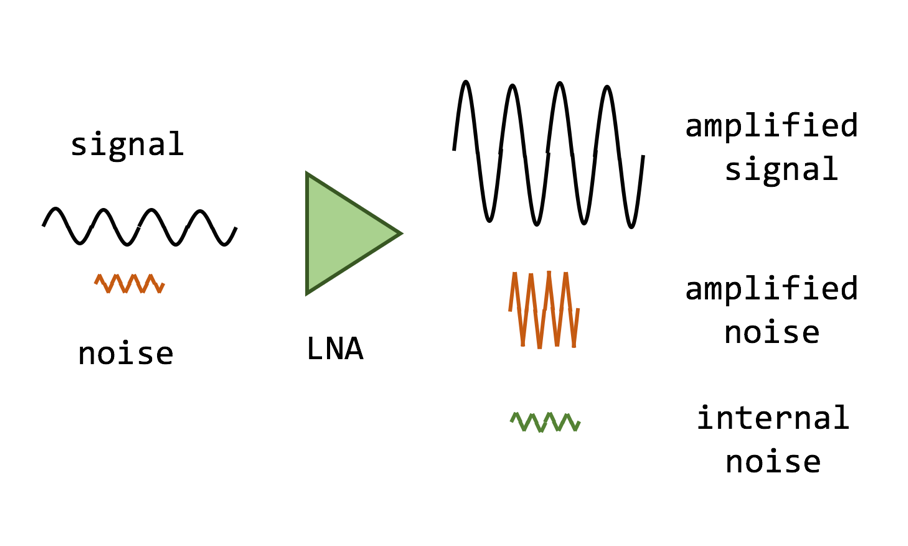
Controlled by RF module register: REG_10<9:8>/<7:5> (
BK4819V3Registers_List
).
LNA Gain Shortis 2 bits, offering 4 values:
| Binary | Decimal | Gain |
|---|---|---|
| 00 | 0 | -19 dB |
| 01 | 1 | -16 dB |
| 10 | 2 | -11 dB |
| 11 | 3 | 0 dB |
LNA Gainis 3 bits, offering 8 values:
| Binary | Decimal | Gain |
|---|---|---|
| 000 | 0 | -24 dB |
| 001 | 1 | -19 dB |
| 010 | 2 | -14 dB |
| 011 | 3 | -9 dB |
| 100 | 4 | -6 dB |
| 101 | 5 | -4 dB |
| 110 | 6 | -2 dB |
| 111 | 7 | 0 dB |
Total gain = LNA Gain Short + LNA Gain.
Example:
LNA Gain Short: 0 → 00 → -19 dBLNA Gain: 2 → 010 → -14 dB
Final gain: -19 -14 = -33 dB
IF: Image Rejection Architecture
According to the
datasheet
, IF includes a low-pass filter (LPF), VGA, and ADC. In the firmware, IF seems to control only LPF bandwidth, via RF register REG_3D<15:0> (
BK4819V3Registers_List
):
IF Selection.
0 = Zero IF;
0x2aab ≈ 8.46kHz IF;
0x4924 ≈ 7.25kHz IF;
0x6800 ≈ 6.35kHz IF;
0x871c ≈ 5.64kHz IF;
0xa666 ≈ 5.08kHz IF;
0xc5d1 ≈ 4.62kHz IF;
0xe555 ≈ 4.23kHz IF;
In AubsUK firmware, the IF values appear as a list without units, assumed to correspond as follows:
0=Zero IF; NOT A MENU OPTION
0x2aab~=8.46kHz IF; 1
0x4924~=7.25kHz IF; 10923
0x6800~=6.35kHz IF; 21845
0x871c~=5.64kHz IF; 32767
0xa666~=5.08kHz IF; 43689
0xc5d1~=4.62kHz IF; 54611
0xe555~=4.23kHz IF; 65533
PGA: Programmable Gain Amplifier
This is a configurable signal amplifier. Gain is set via RF register REG_10<2:0> (
BK4819V3Registers_List
).
PGAis a 3-bit value, providing 8 options:
| Binary | Decimal | Gain |
|---|---|---|
| 000 | 0 | -33 dB |
| 001 | 1 | -27 dB |
| 010 | 2 | -21 dB |
| 011 | 3 | -15 dB |
| 100 | 4 | -9 dB |
| 101 | 5 | -6 dB |
| 110 | 6 | -3 dB |
| 111 | 7 | 0 dB |
Scan Frequency Range Function
This firmware allows scanning a frequency range without needing to switch bands. You simply use the first row of the display to set the scan start frequency and the second row to set the end frequency. This makes scanning much more convenient.
NOTE: It is also possible to enter a stored channel in one row and a frequency in the other row, performing the scan between the two rows.
Battery Calibration
To configure battery settings, you must access the extended menu:
SideKey1 + PTT + Power On
| Option | Menu ID | Function |
|---|---|---|
| BatCal | 66 | Allows you to define the current battery voltage to recalibrate the value shown on the screen. |
| BatTyp | 67 | There are two types of batteries. Depending on the model, the discharge curve varies. Knowing your battery type helps estimate percentage more accurately. |
| 1600mAh: 1600mAh version. | ||
| 2200mAh: 2200mAh version. |
You can calibrate the battery in two ways:
| Manual: Fully charge the battery and adjust the BatCal (66) value until the screen shows 100%. | Multimeter: Use a multimeter to measure the actual battery charge. |
|---|---|
As shown, when returning to the main menu, the displayed value may change. This appears to be a firmware bug. I assume the final value is the one set inside the option itself, not what is shown in the menu.
Functions:
To access the options, press the M(A) button and navigate using the arrow keys. You can also access options directly if you know their ID—for example, if you know that the VOX option is number 56, you can press M(A)+56.
The following table lists all the functions supported by AubsUK, with bold indicating features added compared to the stock firmware , and underlined indicating features added compared to EGZUMER .
| Option | Menu ID | Function |
|---|---|---|
| Step | 1 | How many kHz to step up/down when scanning or manually changing the frequency. |
| TxPwr | 2 | Transmit power, higher power may affect adjacent channels: |
| LOW: 1W | ||
| MID: 3W | ||
| HIGH: 5W | ||
| RxDCS | 3 | Digital reception code: If you’re on a frequency but don’t know the TX code your partner is using, press F+*(Scan) , and the radio will scan DCS codes automatically. |
| RxCTCS | 4 | Analog reception sub-tone: Works like RxDCS but with CTCS tones. |
| TxDCS | 5 | Digital transmit code. |
| TxCTCS | 6 | Analog transmit sub-tone. |
| T-ODir | 7 | Applies positive(+) or negative(-) offset, used with repeaters . |
| T-Offs | 8 | Offset value for repeaters. |
| W/N | 9 | Bandwidth to use: |
| Wide: Less range, better sound quality. Recommended to use low power in Wide mode to avoid interfering with adjacent channels. | ||
| Narrow ( PMR446 ): Greater range, worse sound quality. Narrow mode is more power efficient and less likely to interfere with adjacent channels. | ||
| Scramb | 10 | Encrypted Communication: Enables 1-10 types of scrambling. |
| BusyCL | 11 | Busy Channel Lock: Prevents transmission if the channel is occupied. |
| Compnd | 12 | Compander : improves audio quality by compressing and expanding audio signals, reducing noise and crosstalk . Must be enabled on both radios: |
| TX: Enable compander for transmission only. | ||
| RX: Enable compander for reception only. | ||
| TX/RX: Enable compander for both TX and RX. | ||
| OFF: Disable compander. | ||
| Demodu | 13 | Changes modulation kind : |
| FM: Default | ||
| AM: Receive only | ||
| USB: Receive only | ||
| ScnAdd | 14 | While in channel mode , lets you easily add a channel to a list by simply pressing the list number. |
| ScnLk0 | 15 | In channel mode , permanently prevents a channel from being scanned, regardless of the list. |
| ScnSrt | 16 | If enabled, starts scanning automatically when the radio powers on. Behavior depends on the previous mode: |
| Channel mode : Continues scanning from last use. | ||
| VFO mode : Scans from the last VFO frequency. | ||
| SLists | 17 | View the list(s) a channel belongs to. |
| ChSave | 18 | Save channel. |
| ChDele | 19 | Delete channel. |
| ChName | 20 | Edit the channel name directly on the radio. |
| ScnRev | 21 | Scanning options: |
| CARRIER: Holds scan while signal is present. | ||
| STOP: Pauses scan for 5 seconds then continues. | ||
| TIMEOUT: Stops scanning when a signal is detected. | ||
| F1Shrt | 22 | Configure the SKey1 short press action: |
| FLASH LIGHT | ||
| POWER (toggle TX power) | ||
| MONITOR (open squelch, option 59) | ||
| SCAN | ||
| VOX (toggle VOX, option 56) | ||
| FM RADIO | ||
| LOCK KEYPAD | ||
| SWITCH VFO | ||
| VFO/MR (toggle mode ) | ||
| SWITCH DEMODUL | ||
| SPECTRUM (access spectrum analyzer ) | ||
| NONE (disable button) | ||
| F1Long | 23 | Same as F1Shrt but for long press. |
| F2Shrt | 24 | Configure SKey2 short press. |
| F2Long | 25 | Same as F2Shrt but for long press. |
| MLong | 26 | Same as F1Shrt but for long press of M(A) button. |
| KeyLck | 27 | Automatic keypad lock. |
| TxTOut | 28 | Max transmit time limit. Even with PTT held, transmission stops after X seconds. Useful to save battery or avoid overheating. |
| BatSav | 29 | Active/inactive time ratio to save battery. Aggressive settings may cause signal loss during inactive slots. When PowerSave is enabled, PS appears at the top left of the display: |
| Off: Always checking for signal. | ||
| 1:1: Signal checked half the time. | ||
| 1:2: Signal checked one third of the time. | ||
| 1:3: One out of four time slots. | ||
| 1:4: One out of five time slots. | ||
| Mic | 30 | Microphone sensitivity. |
| MicBar | 31 | Displays a bar showing audio level during transmission. |
| ChDisp | 32 | How memorized channel info is displayed: |
| NAME: Show channel name | ||
| CHANNEL NUMBER: Show channel number | ||
| FREQ: Show channel frequency | ||
| NAME + FREQ: Show both | ||
| POnMsg | 33 | Power On Message: Welcome message when starting up: |
| FULL: Displays the entire screen in black—useful for detecting dead pixels. | ||
| MESSAGE: Message configured from CHIRP . | ||
| VOLTAGE: Displays battery voltage and charge. | ||
NONE: Skips message, goes straight to the A/B channel screen. |
||
| BatTxt | 34 | How the battery level is displayed: |
| NONE: Only shown with the usual bar graph. | ||
| VOLTAGE: Shows voltage next to the battery icon. | ||
| PERCENT: Shows percentage next to the battery icon. | ||
| BatLt | 35 | Duration of screen backlight when active: |
| OFF: Dims to minimum brightness and disables backlight on main screen. | ||
| ON: Keeps the backlight on permanently. | ||
| 5/10/20s 1/2/4m: Disables backlight after the set time. | ||
| BLMin | 36 | Minimum screen brightness when backlight is off. |
| BLMax | 37 | Maximum screen brightness when backlight is on. |
| BltTRX | 38 | Activates screen backlight on signal reception or transmission: |
| OFF: Does not activate the backlight. | ||
| TX: Activates backlight only on transmission. | ||
| RX: Activates backlight only on reception. | ||
| TX/RX: Activates backlight on both transmission and reception. | ||
| Beep | 39 | Enable/disable keypad tone when pressing keys. |
| Roger | 40 | Sends a sound when releasing the PTT to signal end of transmission, like saying “over”: |
| OFF: No sound sent. | ||
| ROGER: Beep. | ||
| MDC: Frog-like tone. | ||
| STE | 41 | Squelch Tail Elimination: Adds an inaudible tone at the end of transmission to suppress noise when releasing PTT. |
| RP STE | 42 | Repeater - Squelch Tail Elimination: Suppresses tone some repeaters send after receiving a signal. |
| 1 Call | 43 | Assigns a channel for quick access by pressing 9(Call) , similar to speed dial. |
| ANI ID | 44 | DTMF ID used in DTMF calls ; can only be edited via CHIRP . |
| UPCode | 45 | DTMF code sent when pressing PTT; PTT ID (47) must be active in BOT or BOTH mode. |
| DWCode | 46 | DTMF code sent when releasing PTT; PTT ID (47) must be active in EOT or BOTH mode. |
| PTT ID | 47 | Sets when to send UPCode (45), DWCode (46), both, or none. Useful for audible ID: |
UP CODE: Sends UPCode when pressing PTT. |
||
DOWN CODE: Sends DWCode when releasing PTT. |
||
| UP+DOWN CODE: Sends UPCode on press and DWCode on release. | ||
APOLLO QUINDAR
: Sends a tone on PTT press and another on release. |
||
| OFF: Disabled. | ||
| D ST | 48 | Allows hearing DTMF codes being sent or received through the speaker. |
| D Resp | 49 | Auto-response to received DTMF call : |
| DO NOTHING: Plays audio if ANI ID (44) matches; acts like auto-answer. | ||
| RING: Same as DO NOTHING, but also rings until user transmits. | ||
REPLY: Same as DO NOTHING, but replies automatically, confirming activity to the sender. Note: works fully only between AubsUK firmware. |
||
| BOTH: Enables both RING and REPLY. Same compatibility note as REPLY. | ||
| D Hold | 50 | DTMF Hold: Keeps the call “auto-answered” for the configured duration after the channel goes silent. |
| D Prel | 51 | DTMF Preload: Delay between signal start and DTMF tones, allowing receiving radios to open squelch in time. |
| D Decd | 52 | DTMF Decoder: Enables detection of DTMF codes; only receives audio if sender transmits matching ANI ID (44). Required for DTMF calls and remote kill . |
| D List | 53 | DTMF contact list: Lets you identify incoming DTMF calls by name. |
| D Live | 54 | Displays received DTMF codes live on screen. |
| AM Fix | 55 | Enables AM autogain feature. |
| VOX | 56 | Voice activation: transmits without pressing PTT when sound exceeds a threshold. |
| BatVol | 57 | Displays battery voltage and remaining charge percentage. |
| RxMode | 58 | Channel receive mode: |
| MAIN ONLY: Only listen/transmit on main channel. | ||
| DUAL RX RESPOND: Listen on both channels; reply on the one with signal. | ||
| CROSS BAND: Listen on secondary, transmit on main. | ||
| MAIN TX DUAL RX: Listen on both, transmit always on main. | ||
| Sql | 59 | Squelch threshold: 0 = always open (more noise and power usage); higher = filters weak signals. |
Extended Menu Access
To access the extended configuration menu, hold:
SideKey1 + PTT + Power On
| Option | Menu ID | Function |
|---|---|---|
| F Lock | 60 | Sets allowed frequency bands for TX and RX. |
| Tx 200 | 61 | Enables transmission in 200 MHz F4 band. |
| Tx 350 | 62 | Enables transmission in 350 MHz F5 band. |
| Tx 500 | 63 | Enables transmission in 500 MHz F7 band. |
| 350 En | 64 | Enables reception in 350 MHz F5 band. |
| ScraEN | 65 | Allows enabling of scrambling via Scramb (10). If disabled here, the normal menu option has no effect. |
| BatCal | 66 | Set actual battery voltage to adjust on-screen value. |
| BatTyp | 67 | Choose battery type to better estimate charge percentage: |
| 1600mAh: 1600mAh version. | ||
| 2200mAh: 2200mAh version. | ||
| Reset | 68 | Reset options: |
| VFO: Resets configuration settings only. | ||
| ALL: Resets both settings and saved channels. |
Buttons and Functions:
| Button | Functionality |
|---|---|
Knob |
Power on and volume control. |
M(A) |
Main configuration menu. Configurable from the PC or the radio: Long press MLong(26). |
Arrow Up(B)/Down(C) |
Navigate through the menu and change parameters. |
Exit(D) |
Exit the menu. |
PTT |
Push To Talk. |
SideKey1 |
Configurable from the PC or the radio: Short/Long press F1Shrt(22), F1Long(23). |
SideKey2 |
Configurable from the PC or the radio: Short/Long press F2Shrt(24), F2Long(25). |
PTT+SideKey2 |
Emits a 1750Hz tone, necessary to access some repeaters. |
SP/MIC Connector |
Speaker/microphone and PC connector. |
USB-C |
USB-C charging port, only use in case of emergency. |
*(Scan) |
Allows making
DTMF calls
by dialing the ANI ID(44), can be cleared using SideKey1. |
0(FM) |
Sets the frequency in VFO mode or channel number in channel mode . |
F(#) |
Activates function mode. |
All keypad buttons have a special function triggered by either combining with the F(#) key or holding the corresponding function button:
| Function | Functionality |
|---|---|
F+0(FM)/Long press 0(FM) |
Turns on the FM radio. |
F+1(Band)/Long press 1(Band) |
Switches the working band. |
F+3(VFO/MR)/Long press 3(VFO/MR) |
Toggles between VFO mode and saved radio stations. |
F+*(Scan)/Long press *(Scan) |
Scans and saves the first 20 stations found. You can delete them in MR mode by pressing M(A). |
Short press *(Scan) |
Scans until a station is found, which can be saved with M(A). Pressing short *(Scan) again will return to previous VFO/MR mode. |
F+2(A/B)/Long press 2(A/B) |
Switches between display lines. |
F+4(FC)/Long press 4(FC) |
Enters
frequency and tone/code detection mode
. Press *(Scan) again if the detected one is incorrect. |
F+5(NOAA) |
Opens the spectrum analyzer . |
Long press 5(NOAA), in VFO mode |
Scans a frequency range . |
F+6(H/M/L)/Long press 6(H/M/L) |
Changes the transmit power TxPwr(2). |
F+7(VOX)/Long press 7(VOX) |
Activates VOX(56). |
F+8(R)/Long press 8(R) |
Activates reverse mode . |
F+9(Call)/Long press 9(Call) |
Switches to the channel set in menu option 1 CALL(43). |
F+*(Scan) |
Identifies the tone/code when tuned to a frequency or channel. |
Long press *(Scan) |
In
MR mode
, starts scanning the enabled scanlists. Pressing long *(Scan) again excludes the channel from the scan until the next reboot. In VFO mode , starts a scan on the current frequency. Press EXIT(D) to stop and return to original frequency, or M(A) to stay on last detected frequency. |
Long press F(#) |
Locks the keypad. |
Unlock Frequencies:
As noted by the original EGZUMER developer , unlocking frequencies only allows listening—not transmitting—and transmitting outside the amateur radio bands could damage the device:
This option won't give you ability to transmit in any other modulation than FM, this is a hardware limitation. Switching to AM or SSB only switches
AF audio output mode of a RF IC. It doesn't switch the whole IC into AM/SSB mode.
This is for listening only. This firmware is also built with additional lock that blocks TX when AM or SSB is on.
Supported bands by the radio:
FM: F1 50∽76 MHz
FM: F2 108∽135.9975 MHz
FM: F3 136∽173.9975 MHz
FM: F4 174∽349.9975 MHz
FM: F5 350∽399.9975 MHz
FM: F6 400∽469.9975 MHz
FM: F7 470∽599.9975 MHz
FM: F7+ XXXXX-XXXXX MHz
AM: F2 108∽135.9975 MHz
To configure this, you must access the extended menu:
SideKey1 + PTT + Power On
From there, you can access various options .
Keep in mind:
- By default, all bands can be received, except
F5, which is controlled via the350 Enoption. - The rest of the options control transmission for each band.
F Lockenables typical ranges by geographic region.- The special
DEFAULToption underF Lockallows extra ranges like 137-174, 400-470 viaTx 200,Tx 350,Tx 500. Tx XXXenables additional bands only ifDEFAULTis selected.
F Lock(60) - Assigns permitted transmission bands.
DEFAULT + (137-174, 400-470) - Enables TX in F3 and F6 with optional expansion via Tx 200, Tx 350, Tx 500.
FCC HAM (144-148, 420-450)
CE HAM (144-146, 430-440)
GB HAM (144-148, 430-440)
(137-174, 400-430)
(137-174, 400-438)
DISABLE ALL - Disables all transmission.
UNLOCK ALL - Enables transmission on all frequencies.
Tx 200 - Enables TX in 200MHz F4.
Tx 350 - Enables TX in 350MHz F5.
Tx 500 - Enables TX in 500MHz F7.
350 En - Enables RX in 350MHz F5.
If you insist on enabling TX in all bands, you must follow a
very specific procedure
: access the extended menu and activate F Lock(60) -> UNLOCK ALL 10 times in a row.
In my case, I’m enabling only the typical amateur radio frequencies. The relevant configuration is:
F Lock(60): DEFAULT + (137-174, 400-470)
Tx 200 - OFF
Tx 350 - OFF
Tx 500 - OFF
350 En - ON
As shown, this setup allows receiving all bands but only transmitting on amateur radio bands:
| Frequency Band TRX Configuration | Full Frequency TRX Unlock |
|---|---|
Note: Even with unlocked frequencies, TX is only in FM. You cannot transmit in AM, and transmission power outside ham bands is very poor, since the hardware was not designed for those ranges.
DTMF Calls:
The basic idea is to have a group of walkies all on the same frequency and be able to call one or more of them using DTMF codes. Each walkie must have a unique identifier called ANI ID (44), which can only be configured via the PC software .
If you transmit on the channel without dialing an ANI ID (44), no one with D Decd (52) enabled will hear you. The green LED will light up, indicating that a signal is being received, but no audio will be played. However, if you dial an ANI ID (44) that matches one of the walkies, it will immediately receive the audio—no need to “answer” the call.
The D Resp (49) configuration parameters apply only to the receiving walkie:
- DO NOTHING: If the walkie receives its ANI ID (44), the audio is played through the speaker. Think of it as an auto-answer phone.
- RING: Works the same as DO NOTHING, but also plays a ringtone, which only stops when the receiver transmits something.
- REPLY: Works the same as DO NOTHING, but the receiving walkie also responds, so the caller knows the other side is active and ready to receive audio. When calling from stock firmware to
AubsUK, the receiver responds but the caller doesn’t detect it. Flashing both withAubsUKresolves the issue. - BOTH: Enables both RING and REPLY. It suffers the same issue as REPLY when using mixed firmware.
If transmission stops, the call remains “auto-answered” for the time configured in D Hold (50). To cancel a call, press the Exit (D) key. To delete a character in DTMF dial mode, press SideKey1.
You can place calls in several ways:
- Manually: Hold
PTT, dialreceiver's ANI ID*your ANI ID. Example: if your ID is 666 and you’re calling 100, you would dial100 * 666. In my tests, only the receiver could hear the audio, even with REPLY enabled. - Automatically: Press
*, then dial thereceiver's ANI ID, thenPTT. In this mode, your ANI ID is sent automatically.
To call a group, set the Local Code via the
PC software
. Assuming it’s #, calling 12# reaches IDs 120–129, 1## reaches 100–199, and ### reaches 000–999 (all possible users). The REPLY function does not work with group calls; the caller speaks blindly.
Keep in mind this is still an open channel: anyone can transmit or receive on your frequency once a call is auto-answered. If someone calls a walkie, that walkie opens communications. At that moment, any third party transmitting on the same frequency can be heard by both “friendly” walkies, and that third party could always hear the audio from them as well.
Here’s a demo video using DTMF contacts and D Resp (49) set to BOTH. You can see the firmware compatibility issues:
- Stock firmware → AubsUK: Caller doesn’t detect receiver’s response, but squelch opens on both devices.
- AubsUK → Stock firmware: Signal is received (green LED), receiver doesn’t respond, squelch opens only on the caller.
- AubsUK → AubsUK: Works flawlessly.
| Stock → AubsUK | AubsUK → Stock | AubsUK → AubsUK |
|---|---|---|
Depending on whether the walkie is calling or receiving, the display lines will show different info:
| Caller | Receiver | |
|---|---|---|
| Top line | Call status info | Call origin |
| Bottom line | Call destination | Call destination |
Changing D Hold (50) / D Prel (51) doesn’t seem to make a difference.
NOTE: If two devices are set with the same ANI ID (44), both will respond to the call, and all three (caller + two receivers) can hear and talk to each other.
Frequency Scanner
This walkie has a very useful function called Frequency Scanner: FC. It allows you to detect the frequency and
tone/code
another walkie is using. Just activate the function: F+4 (FC) / long-press 4 (FC) and wait for the other walkie to transmit.
You can save the configuration to a memory slot by pressing M(A). This is especially helpful when working with inexperienced users who don’t know their settings.
Another related feature is the Tone/Code Scanner. If you know the frequency but not the
tone/code
, press: F+* (Scan), and it will automatically detect it. Then you can save it to a channel using M(A).
| Frequency Scanner: F+4 (FC) / long-press 4 (FC) | Tone/Code Scanner: F+* (Scan) |
|---|---|
Scrambling
You can “encrypt” conversations using scrambling Scramb (10). It just distorts the signal with a scrambling code. Walkies without this setting will hear garbled audio.
Here’s a video showing the effect:
Note that in Spain, encrypting radio communications is illegal, so be cautious with this option. If you want to ensure scrambling can’t be accidentally activated, you can disable it via the extended menu:
SideKey1 + PTT + Power On
ScraEn: OFF
When disabled, the SCR option appears in the menu but does nothing, and the SCR label doesn’t show below the frequency:
Remote Kill
You can disable a walkie remotely by sending a DTMF tone sequence(Kill code). This is called Remote Kill. If the lost walkie is later found, you can restore it using a Revive code. For this to work, D Decd (52) must be enabled on the active channel.
We can see on the left the configuration of the walkie-talkie on the left in the video, and on the right the configuration of the walkie-talkie on the right in the video.
| Left Walkie | Right Walkie |
|---|---|

|

|
To kill walkie 666: ANI ID * Kill code, e.g., 666 * 66066
To revive it: ANI ID * Revive code, e.g., 666 * 66166
In the demo, neither code seems to have any effect. The device interprets it as a
DTMF call
, but oddly: only the receiver hears the audio and the origin of the call is displayed as 660:
If you enable DTMF kill lock:

The walkie will lock up without needing to receive any code, and can only be unlocked by receiving the Revive code or by reprogramming it from
CHIRP
with the option disabled:
NOTE: This might be useful if you want to restrict someone’s use of the walkie until a certain time/date. You could give it to them locked and unlock it when needed—but once unlocked, it stays that way.
After receiving the Revive code, if you read the configuration in
CHIRP
, you’ll see the option has been turned off:

CHIRP:
CHIRP
is a widely used configuration software that supports a large number of devices. To proceed with its installation, we must first create a Python virtual environment and install the
latest version of the software
.
Venv and CHIRP installation:
cd chirp
wget https://archive.chirpmyradio.com/chirp_next/next-20250606/chirp-20250606-py3-none-any.whl
pip install chirp-20250606-py3-none-any.whl
We activate the venv and run the software:
chirp
We can create an alias to start CHIRP directly in the venv like this:
alias chirp='~/chirp/bin/python ~/chirp/bin/chirp'
To interpret the new data structure of the EPROM used by AubsUK, it is necessary to start CHIRP in developer mode and load
the driver.
Enable developer mode:
Help -> Developer mode

|
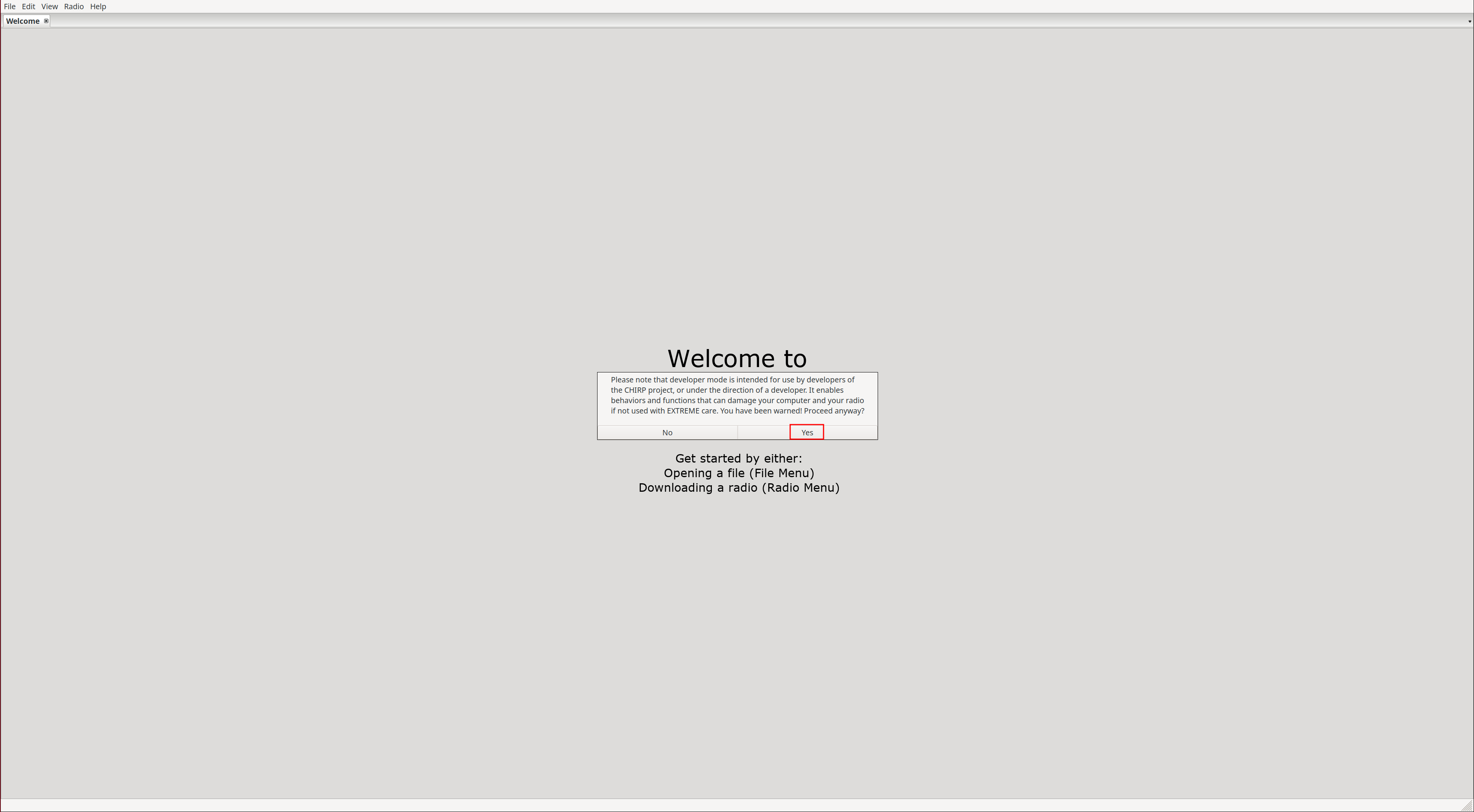
|
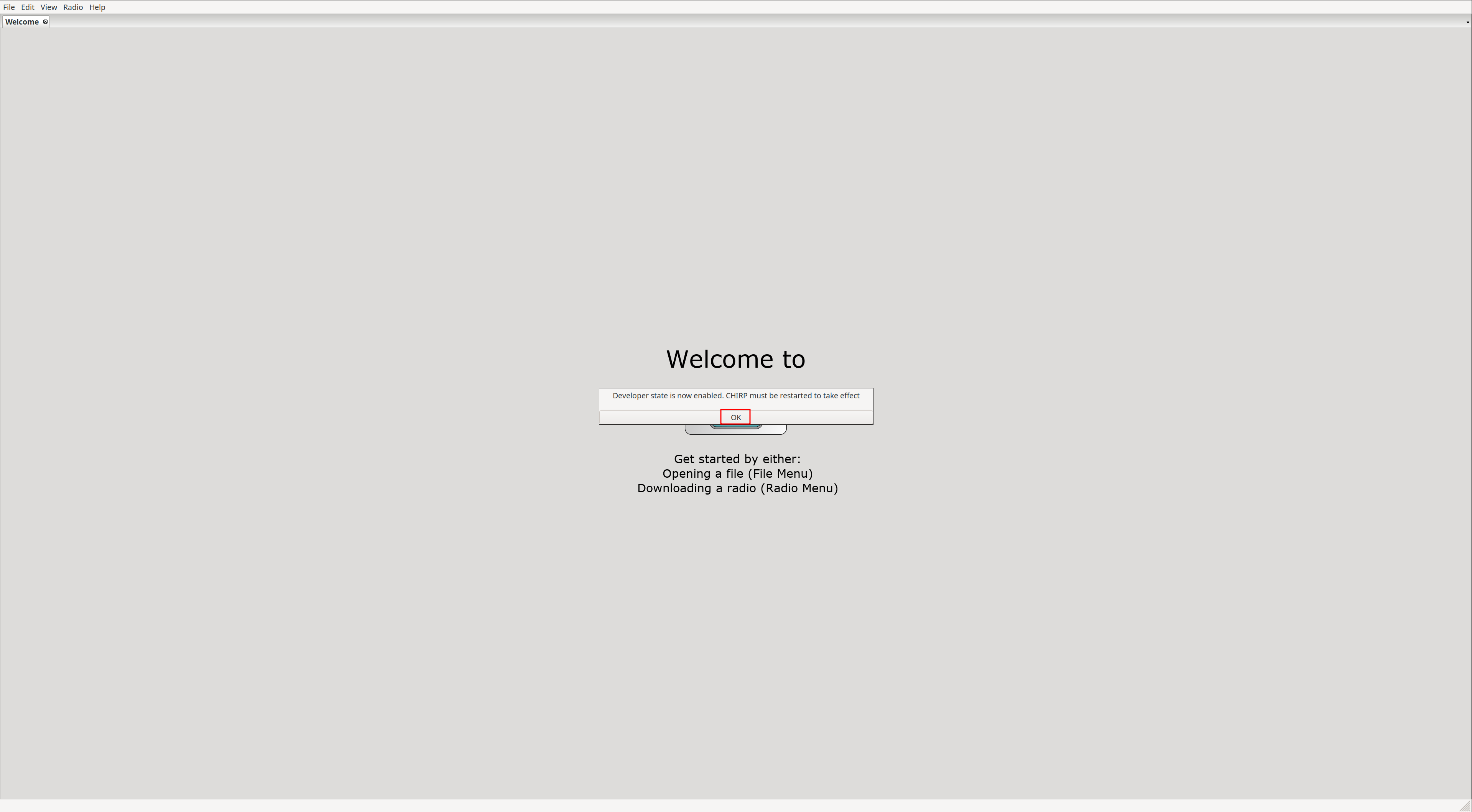
|
After restarting, we can load the driver:
File -> Load Module...
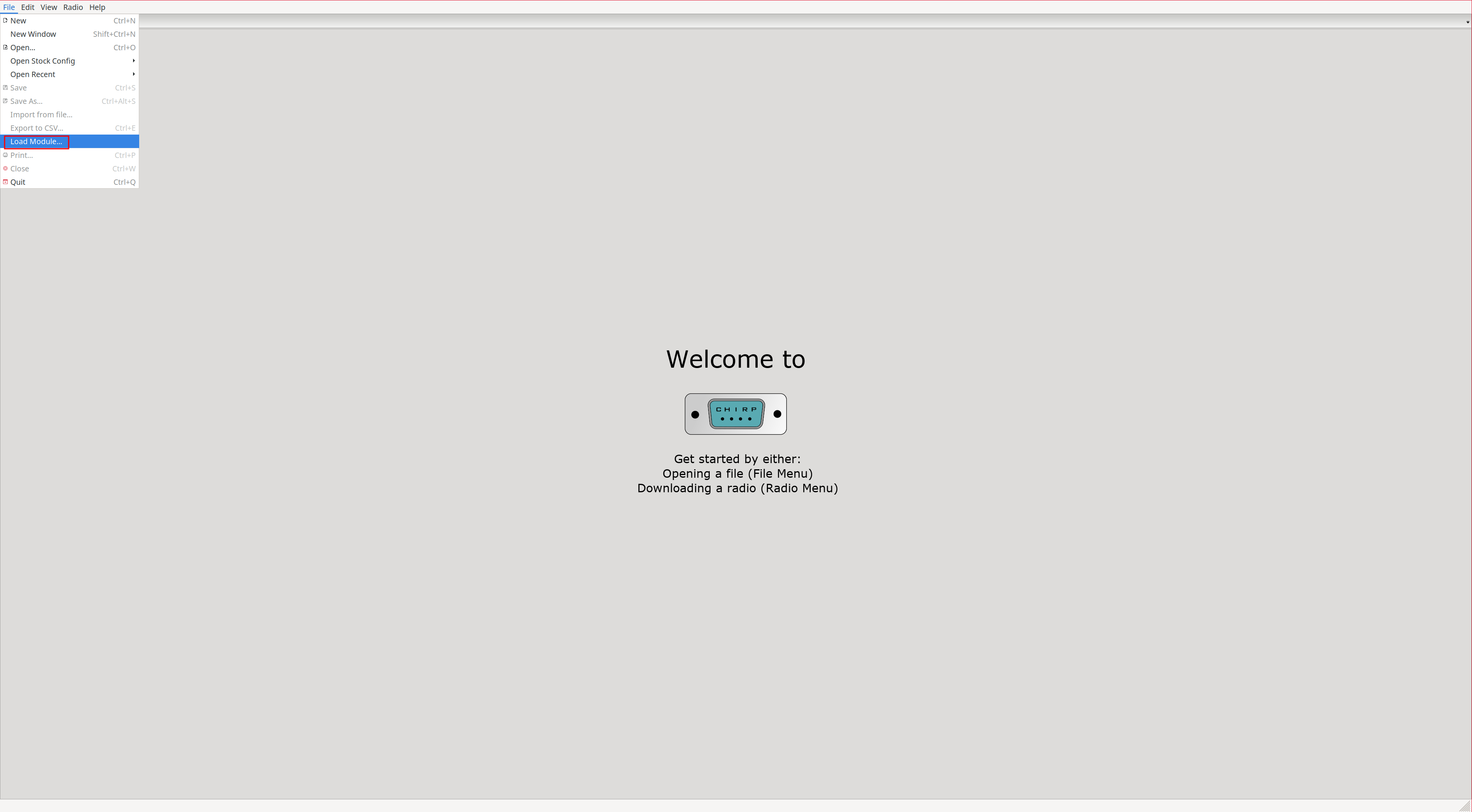
|
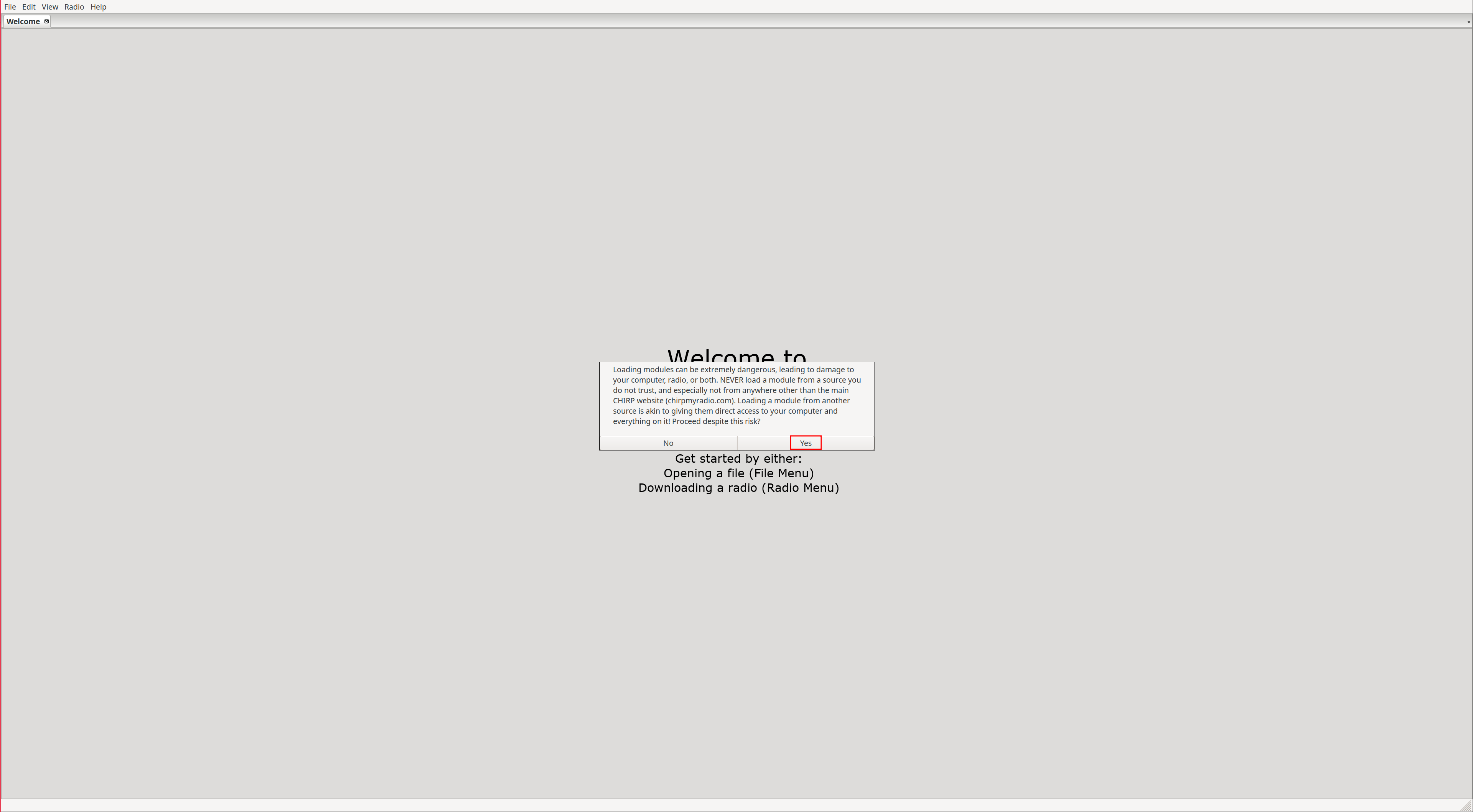
|
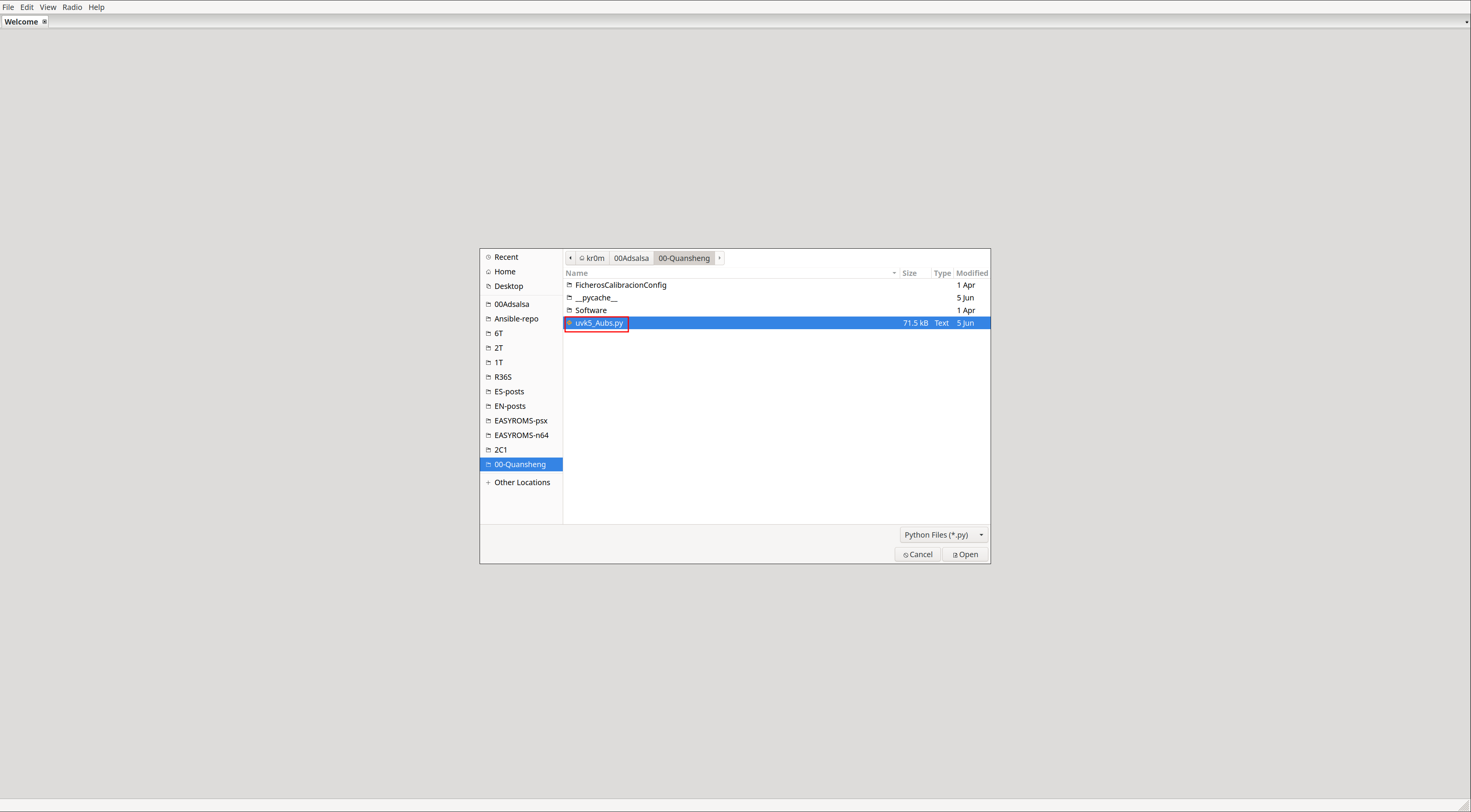
|
NOTE: CHIRP is quite a clunky software, for example, if we select a value from a dropdown but do not remove focus from the parameter, it will NOT be applied, meaning if we upload the configuration to the radio, it will not have been applied.
Extra fields:
The first step before configuring anything is to enable Extra fields so we can see all the configuration parameters of AubsUK.
View -> Show extra fields
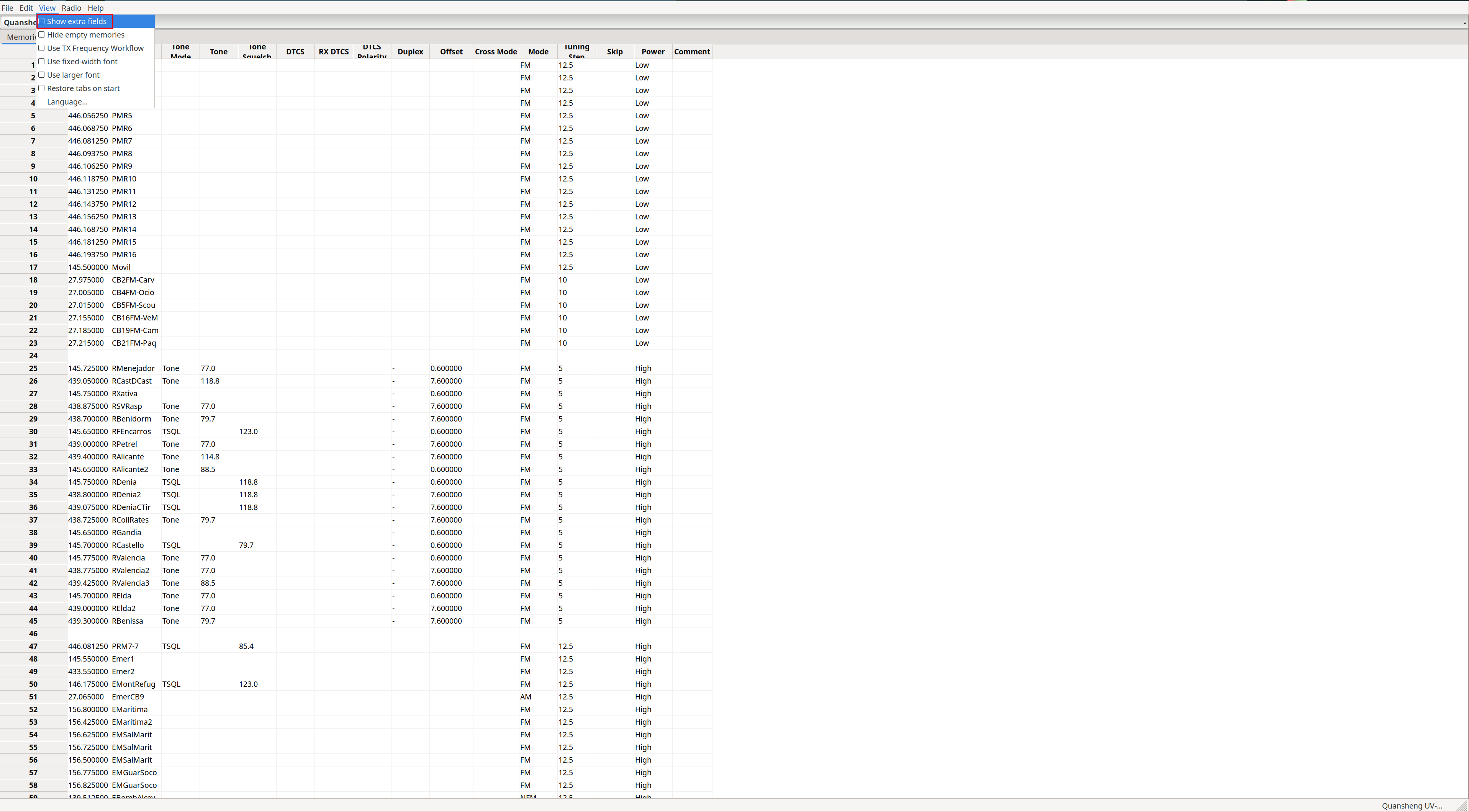
|
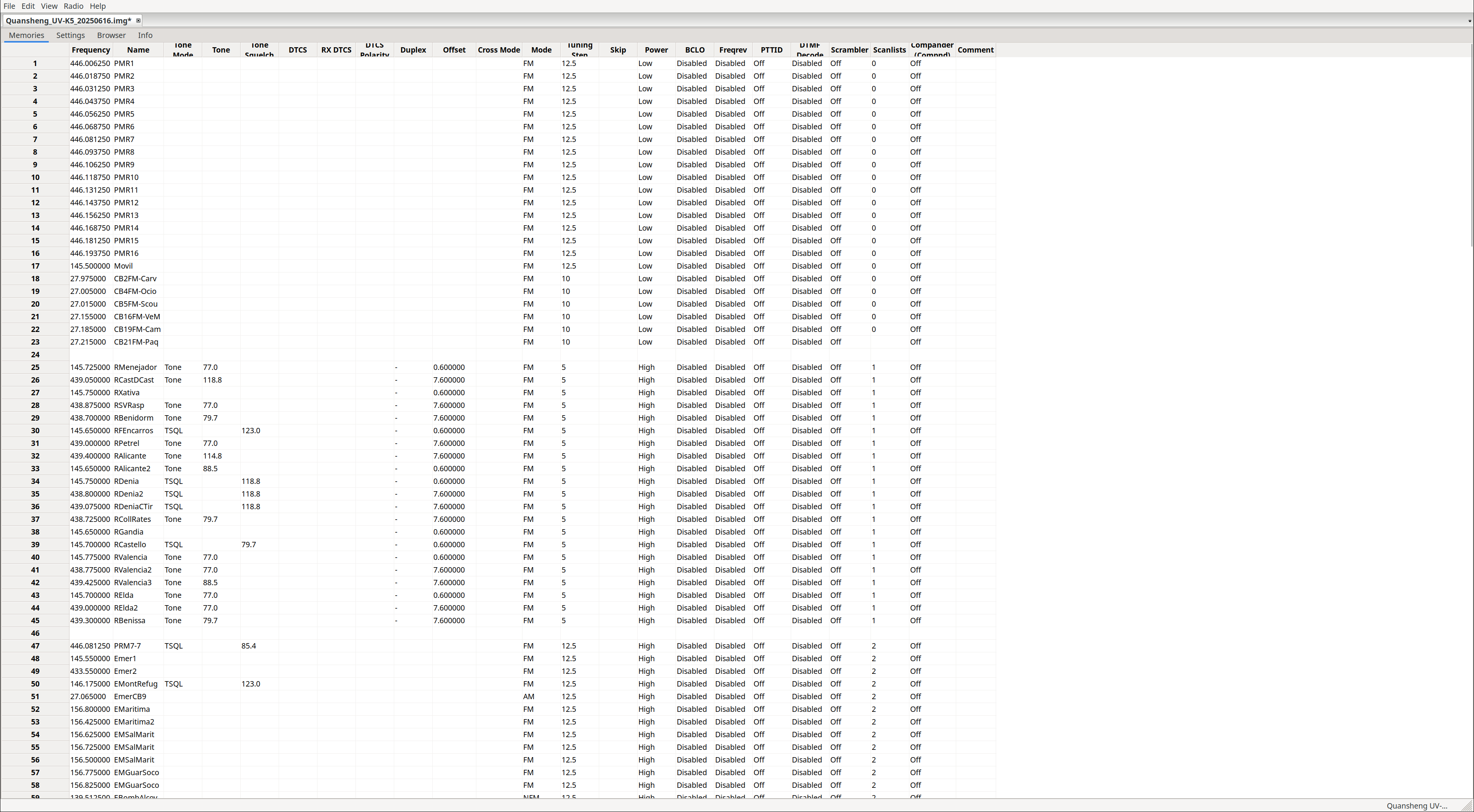
|
Connect to the radio:
Radio -> Download from radio

|
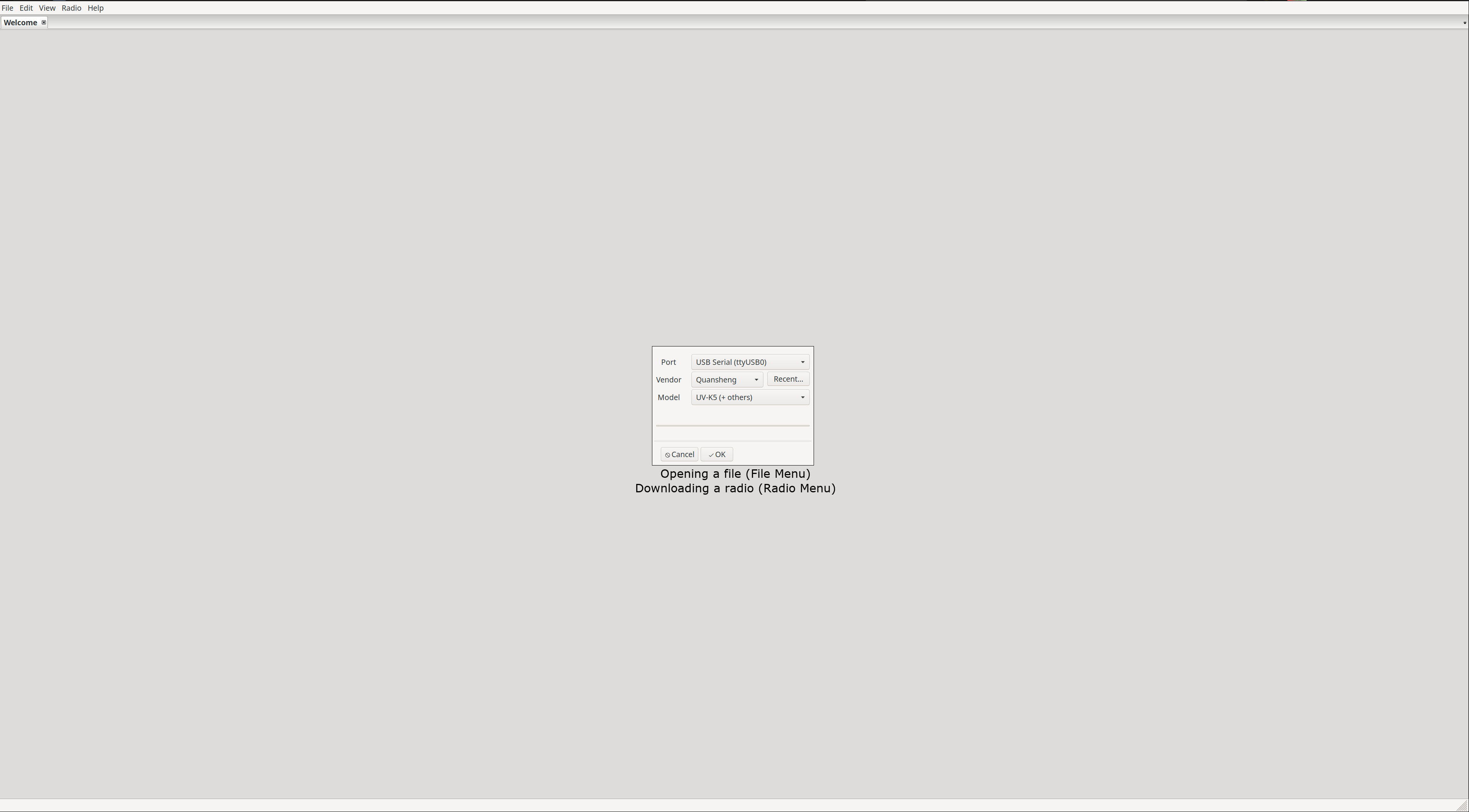
|
Channel list:
It will show us the channels. In my opinion, the interface leaves much to be desired since it is very complicated to understand what each field means; it would have been much simpler to map one column for each menu option on the walkie like
CPS
does. Despite its lack of intuitiveness, I will try to explain what
each parameter
does:

The DTCS Polarity option specifies the polarity of the output/input
tone/code
. The tones only allow positive polarity (N) while digital codes allow positive (N) and negative (R) polarity:
| Value. | Output polarity. | Input polarity. |
|---|---|---|
| NN | Positive | Positive |
| NR | Positive | Negative |
| RN | Negative | Positive |
| RR | Negative | Negative |
The Tone Mode option can take one of the following values:
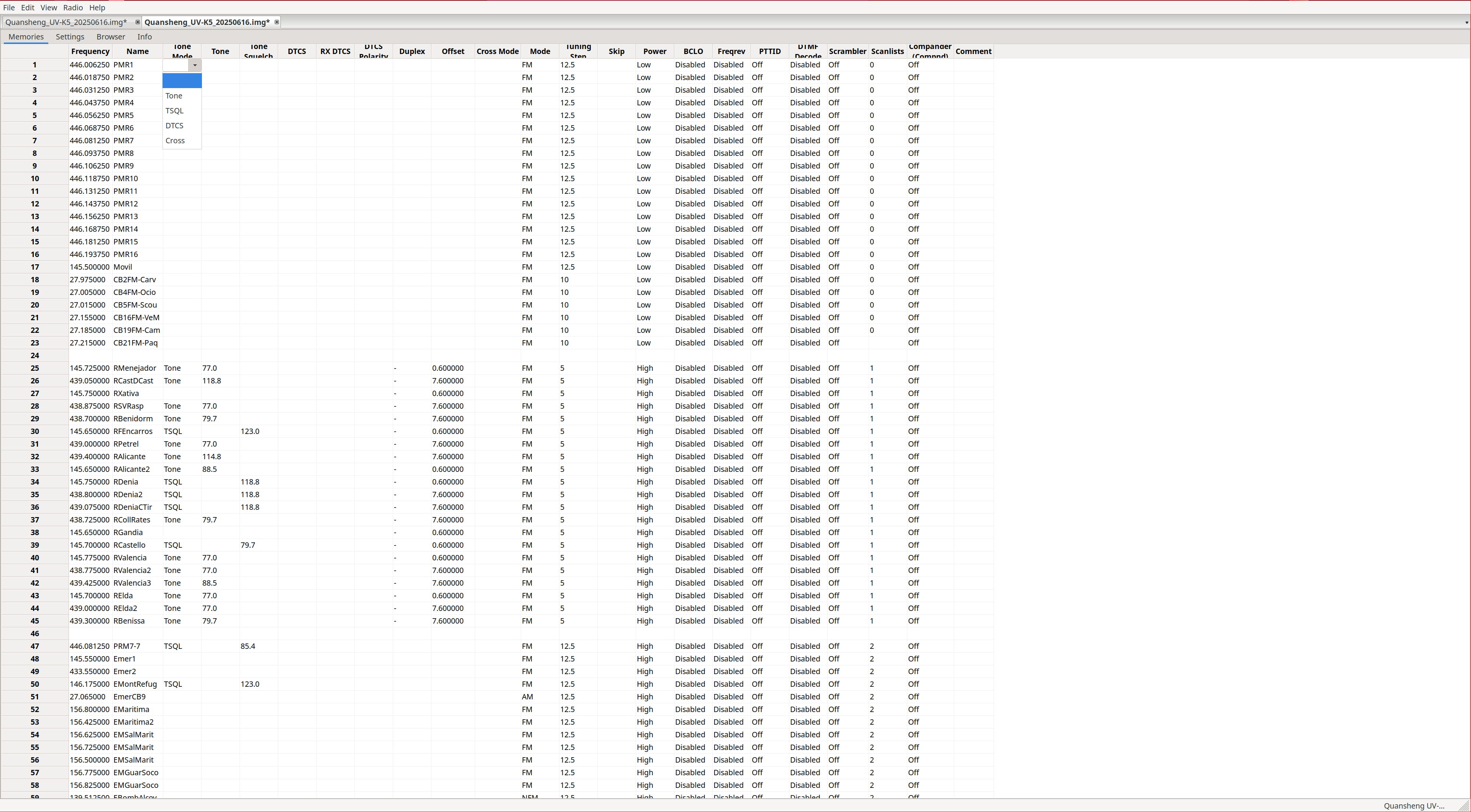
| Value. | Output code/tone. | Input code/tone. |
|---|---|---|
| None | No tone/code assigned | No tone/code assigned |
| Tone | Tone: Tone column | No tone/code assigned |
| TSQL | Tone: ToneSquelch column | Tone: ToneSquelch column |
| DTCS | Code: DTCS column | Code: DTCS column |
| Cross | Mixed configuration | Mixed configuration |
NOTE: Cross: This mode must be set when we want to do mixed configurations, i.e., not only codes or only tones, but to be able to choose for input whether we will use codes or tones and similarly for output. This field depends on another column: Cross Mode.
The Cross Mode column determines whether codes or tones will be used; the first field indicates transmission and the second reception:

| Value. | Output code/tone | Input code/tone |
|---|---|---|
| Tone -> Tone | Tone: Tone column | Tone: ToneSquelch column |
| Tone -> DTCS | Tone: Tone column | Code: RX_DTCS column |
| DTCS -> Tone | Code: DTCS column | Tone: ToneSquelch column |
| -> Tone | No tone/code assigned | Tone: ToneSquelch column |
| -> DTCS | No tone/code assigned | Code: RX_DTCS column |
| DTCS -> | Code: DTCS column | No tone/code assigned |
| DTCS -> DTCS | Code: DTCS column | Code: RX_DTCS column |
NOTE: For some reason the option Tone -> is missing, a CHIRP quirk; hopefully, they will fix these kinds of issues over time, remember support for Quansheng is still experimental.
Some modes are more restrictive than others; for example, if we configure only digital code as output, it makes no sense to have an input tone configured. These restrictions are detected but not very well, so you have to click on more fields even if you are not changing anything for them to apply.
Band list:
Similarly to how we did it with
CPS
, from CHIRP it is also possible to define the start and end of each band:
FM: F1 50∽76 MHz
FM: F2 108∽135.9975 MHz
FM: F3 136∽173.9975 MHz
FM: F4 174∽349.9975 MHz
FM: F5 350∽399.9975 MHz
FM: F6 400∽469.9975 MHz
FM: F7 470∽599.9975 MHz
FM: F7+ XXXXX-XXXXX MHz
AM: F2 108∽135.9975 MHz
To modify the parameters, we must scroll down to the bottom of the channel list:
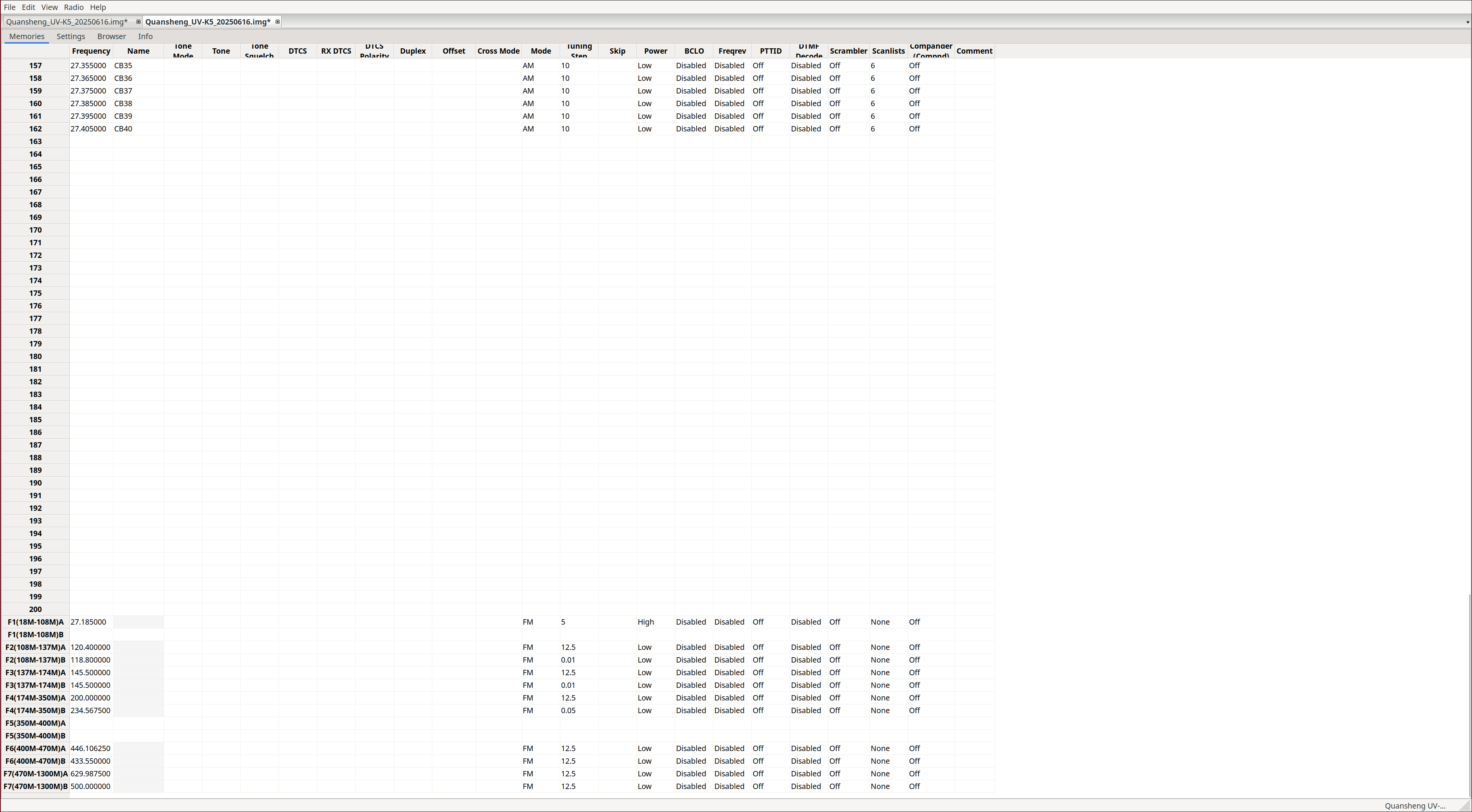
By modifying these parameters, we will alter the frequency limits when scanning a band and default band parameters such as tones/codes , bandwidth, output power, and other parameters. Of course, we can always modify these parameters on the fly from the walkie menu.
Settings:
In the Settings tab, we can find the rest of the configuration.
Basic Settings:
As we can see, AubsUK thoughtfully indicates which walkie parameter corresponds to each option.
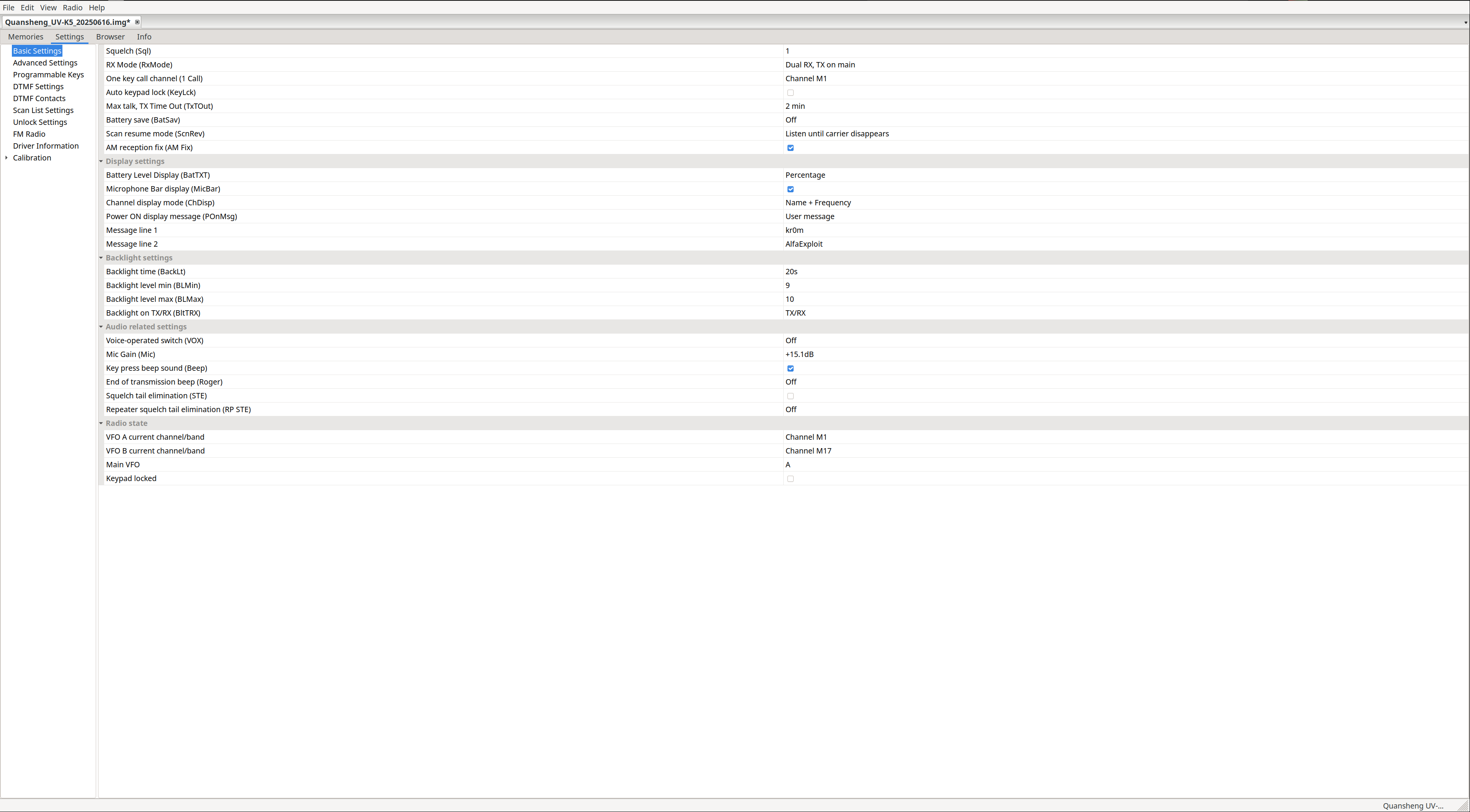
Advanced Settings:
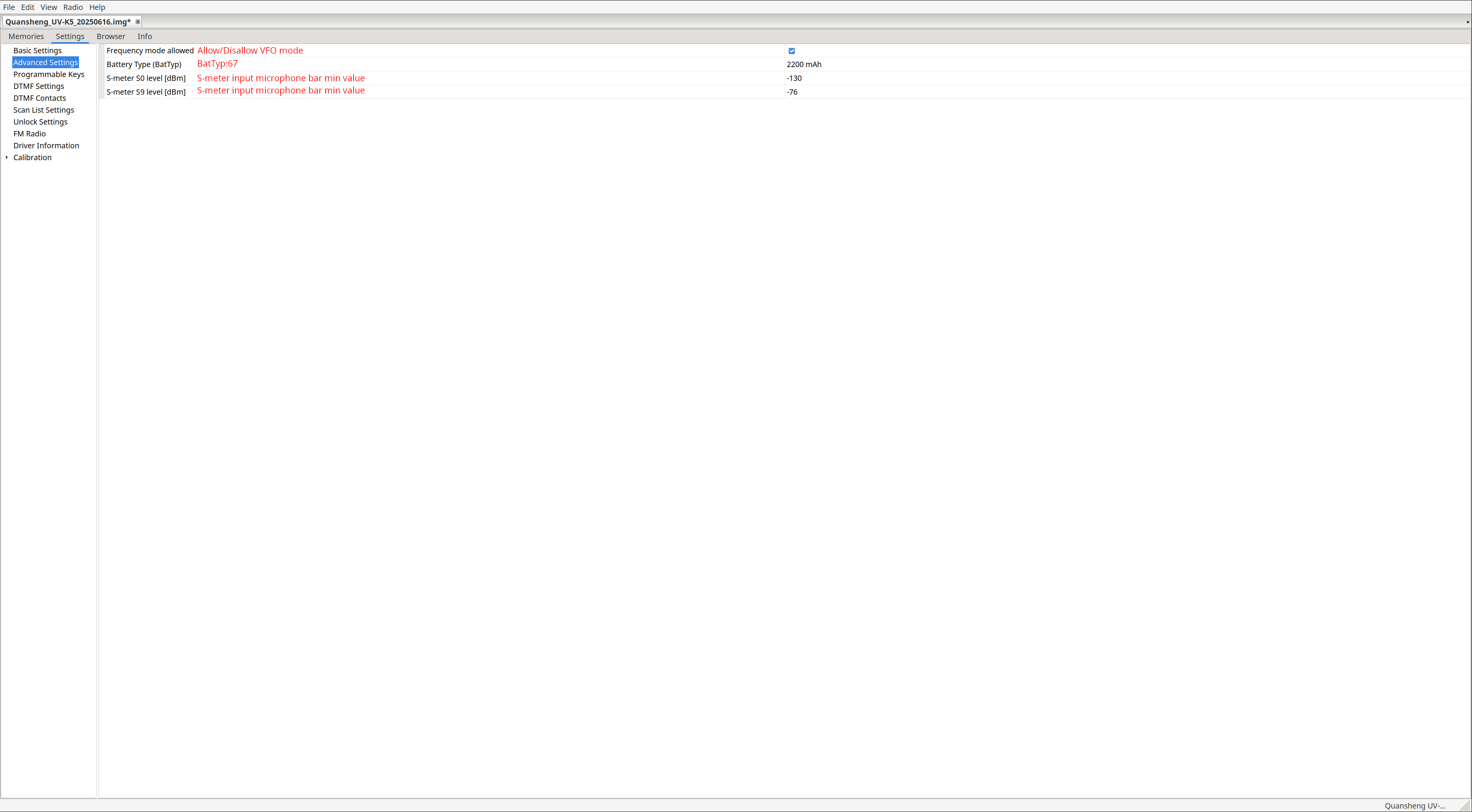
Programmable keys: SideKeys configuration.
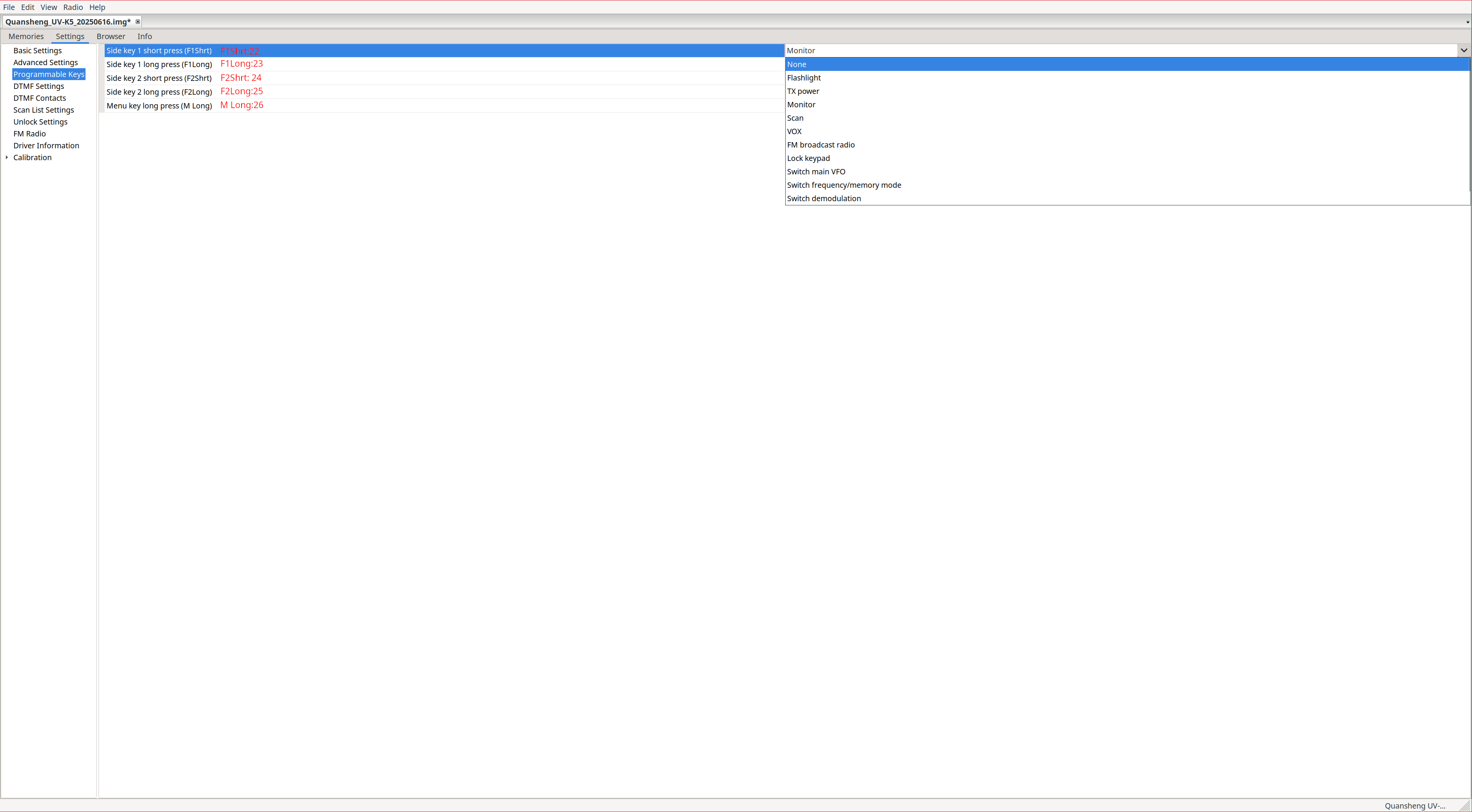
DTMF Settings: Configuration of DTMF parameters.
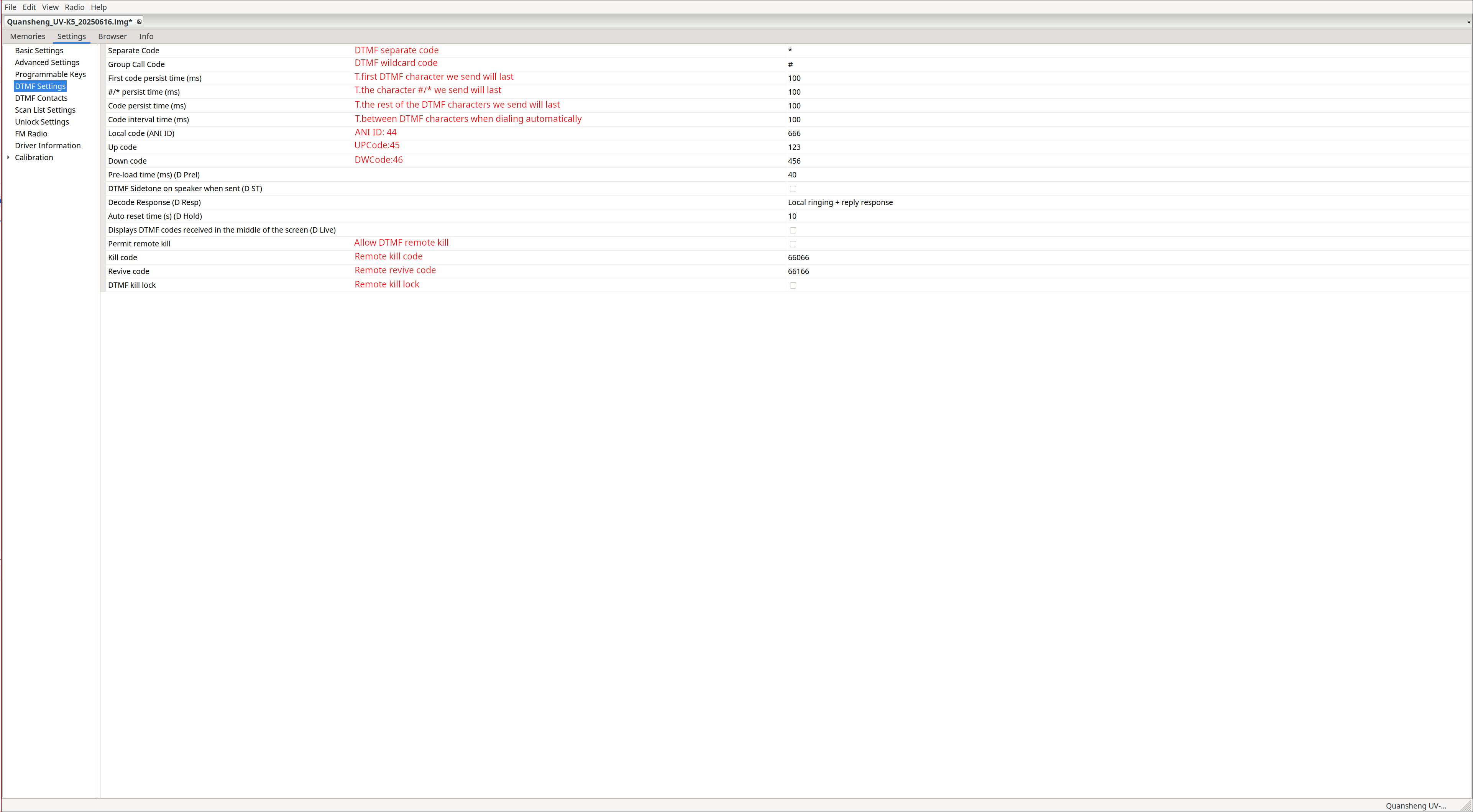
NOTE: Keep in mind that the
DTMF remote kill
function does not work properly on AubsUK.
DTMF Contacts: DTMF contacts configuration.
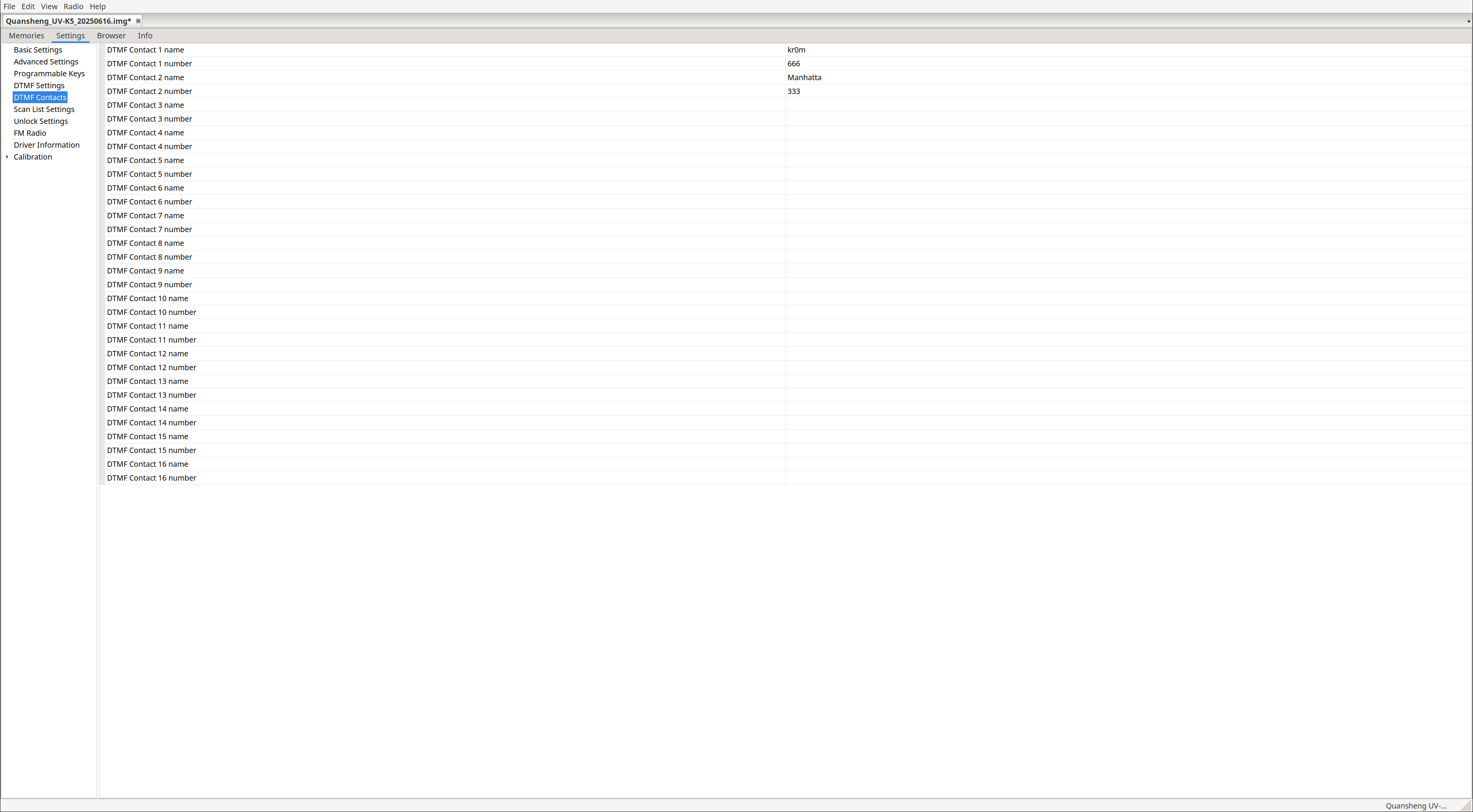
Scan Lists: From here, we can configure if we want the radio to start scanning on boot and which lists to scan when scanning is active.
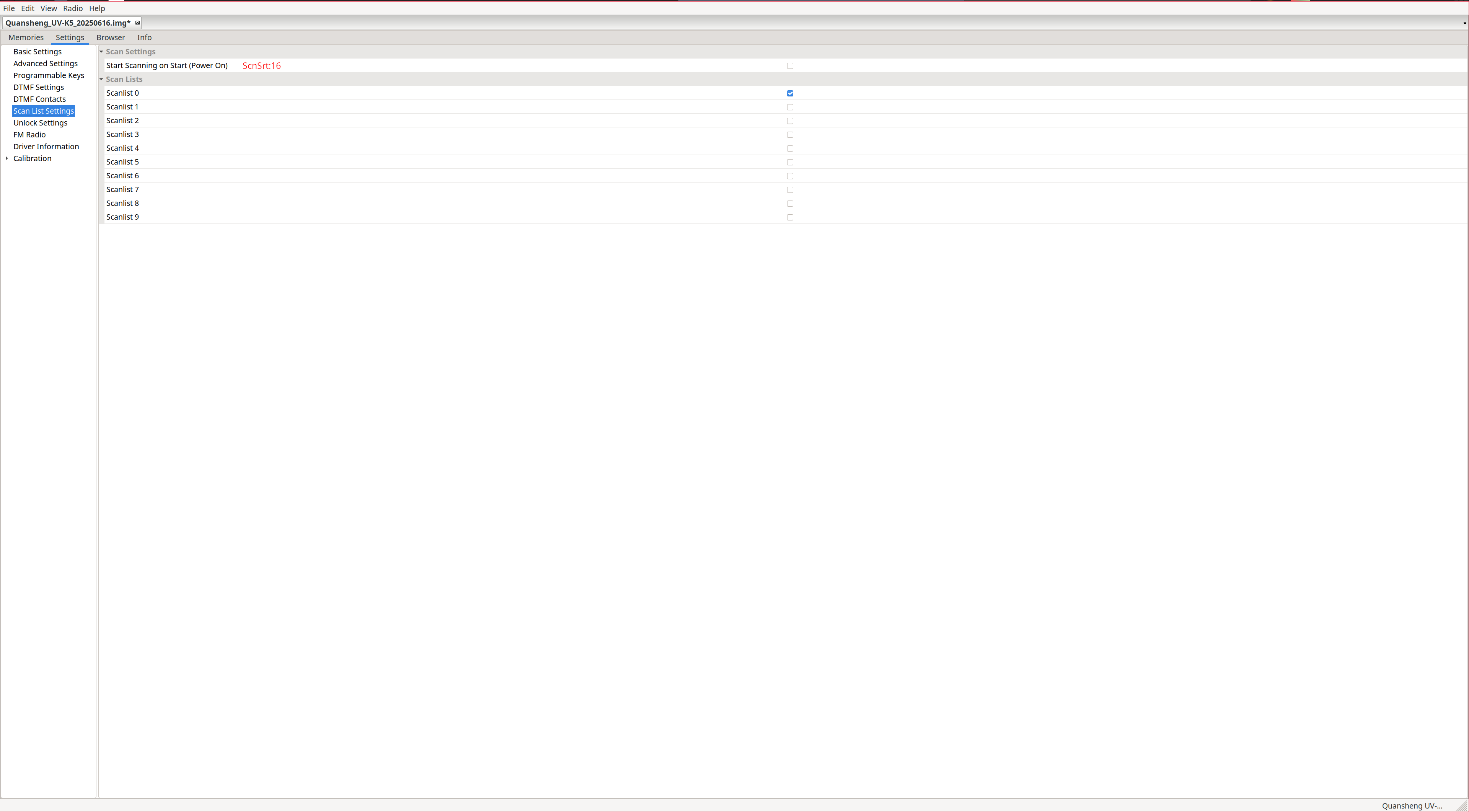
Unlock Settings: Allows us to
unlock transmission on frequencies
outside the amateur radio range and enable/disable the use of
scrambling
, just like from the extended menu.
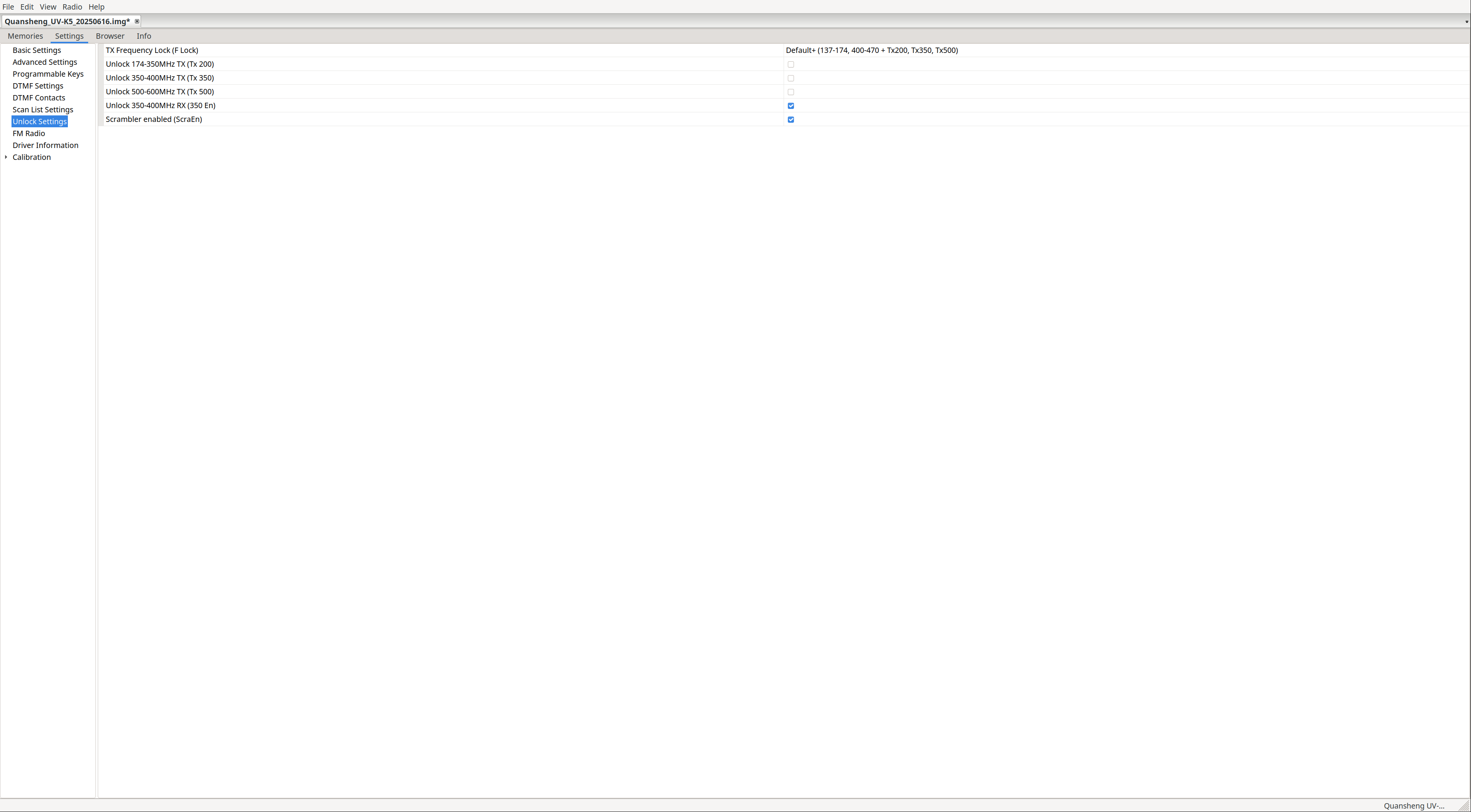
FM Radio: Allows editing of saved radio channels.
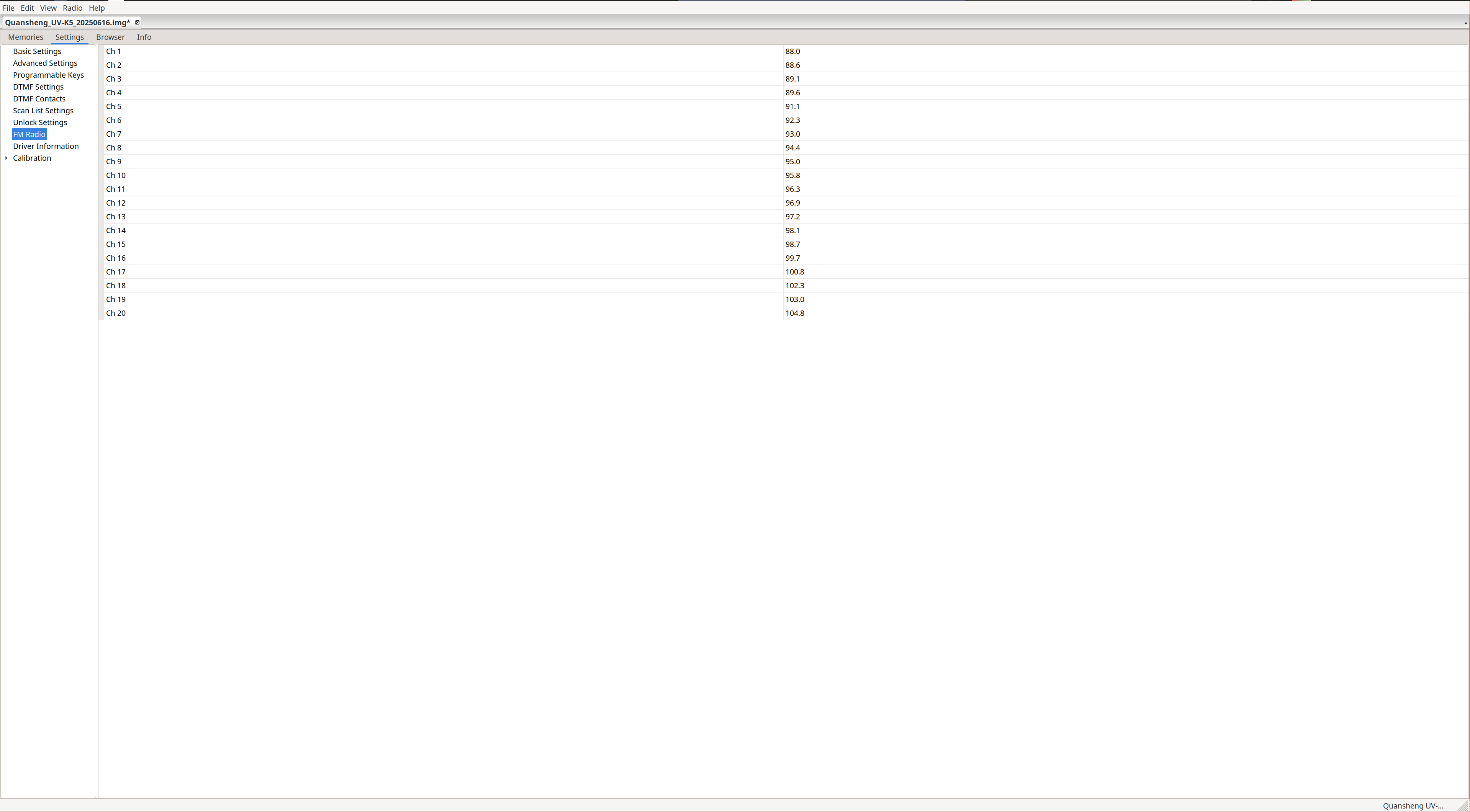
Driver information: Shows firmware version.
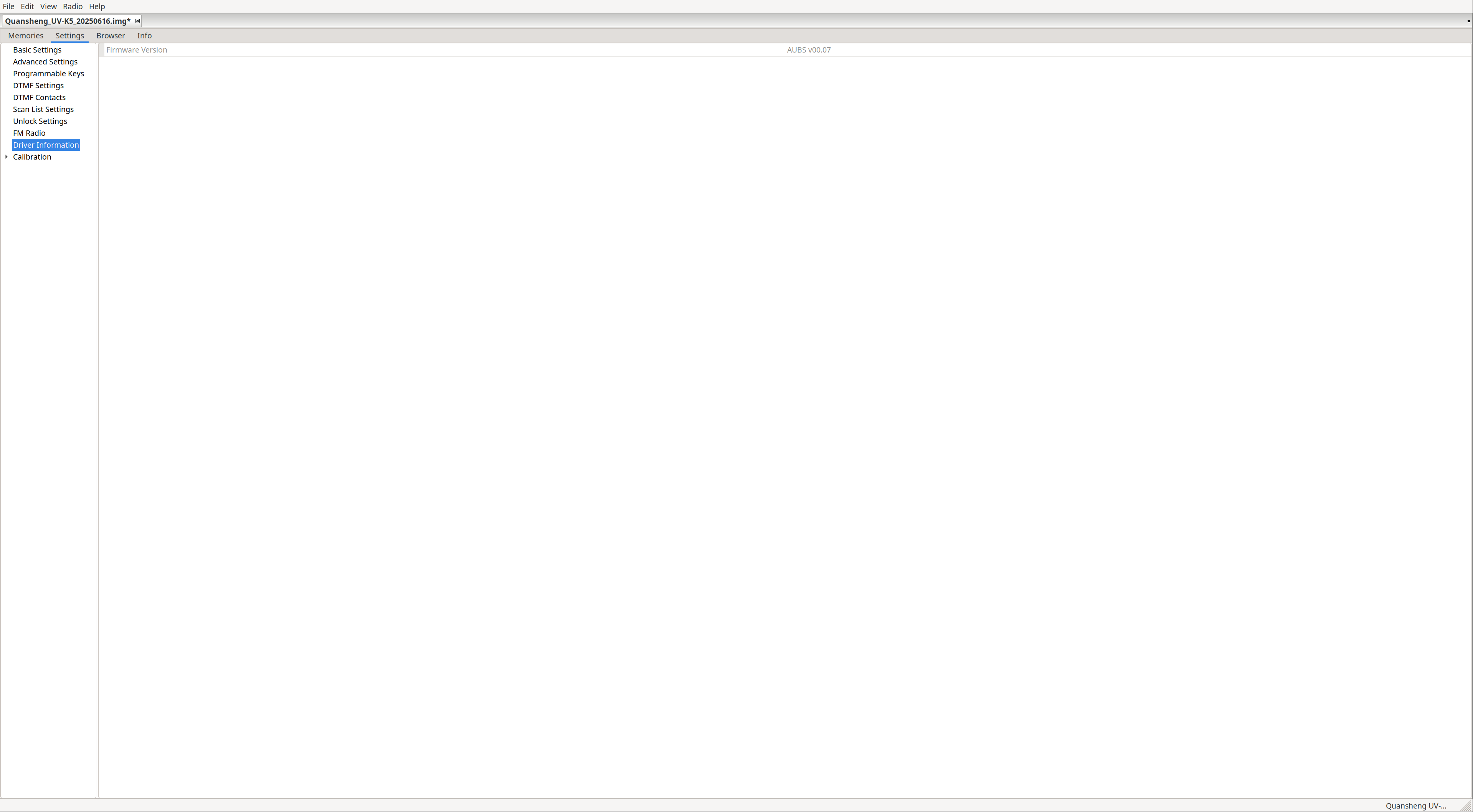
Calibration: Allows adjustment of calibration parameters. As indicated on the
EGZUMER website
, CHIRP saves radio calibration parameters in the files it generates when saving, so if someone shares their CHIRP file with us and this option is enabled, we will be loading their calibration.
The best way to back up our calibration is through
k5prog-win.
Some parameters that the
AubsUK (EGZUMER) firmware does not use at all
are shown by CHIRP as values in the EPROM but are unused.
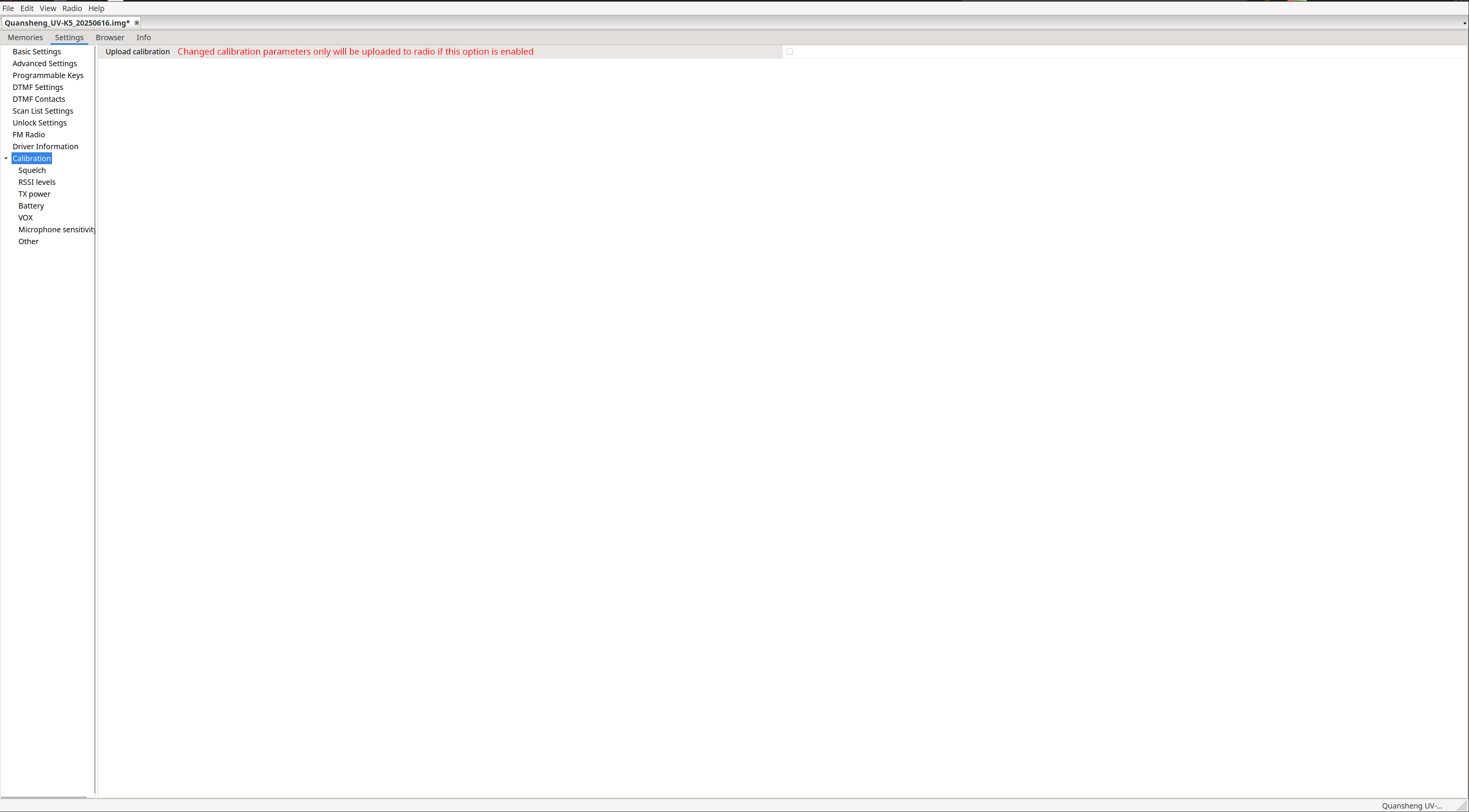
Calibration-Squelch: Allows adjustment of squelch parameters per level (59). Only two configurations are allowed, one for the first three bands and one for the next four.
These values are read and multiplied by two by the firmware.

Calibration-RSSI levels: We can define signal quality thresholds to show X or Y bars, only two configurations allowed, one for the first three bands and one for the next four.
Only used if the firmware was compiled with ENABLE_RSSI_BAR=0 option.
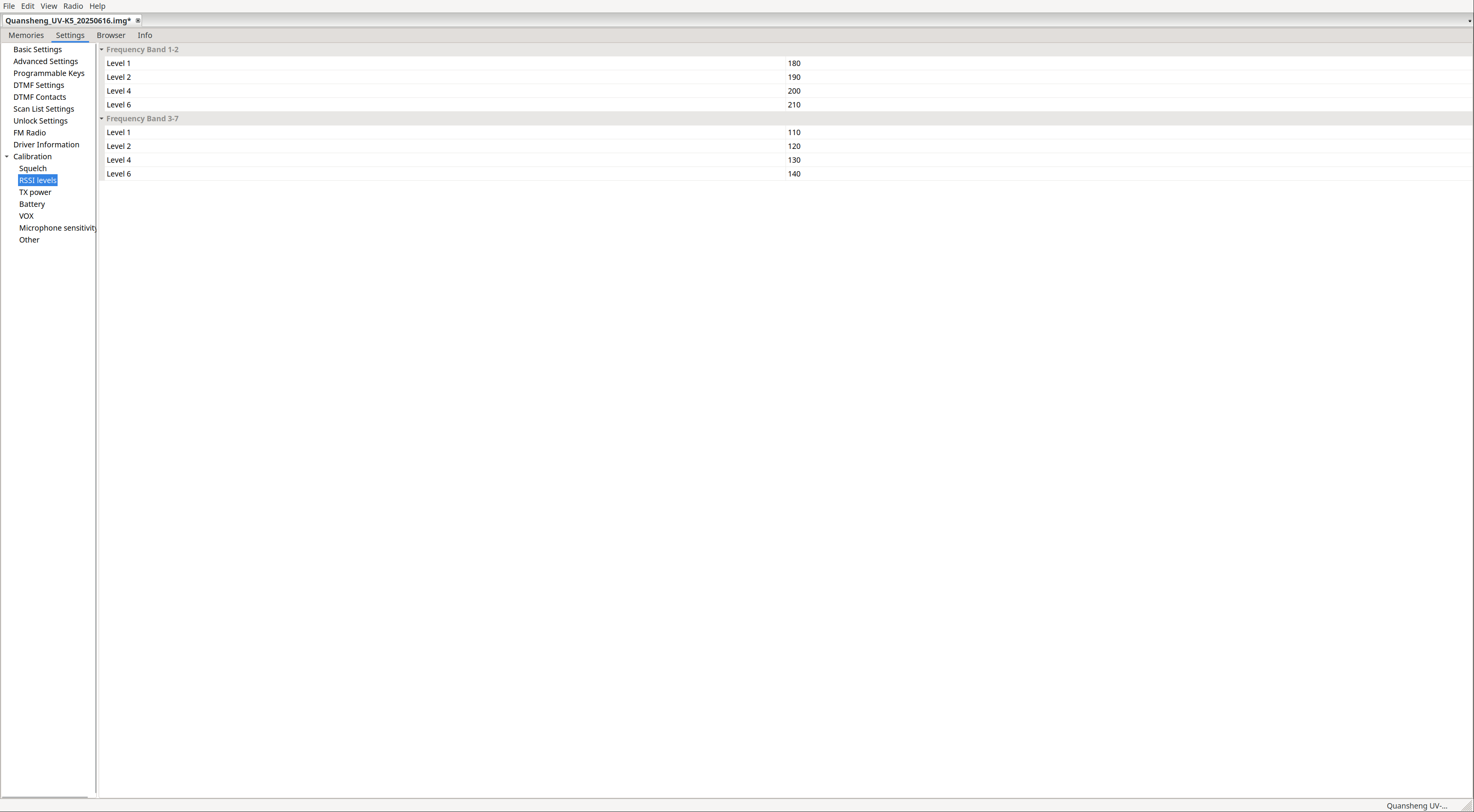
Calibration-TX power: Allows defining transmit power per band. If firmware is compiled with the ENABLE_REDUCE_LOW_MID_TX_POWER option enabled, medium power value is divided by 3 and low power by 5.
You can see Lower/Center/Upper values; this is because bands are divided into regions of X MHz, according to the band region we are operating in, a different power will be applied. For example, if we are in band F1 with the walkie configured to Low power, while in the lower region we transmit at: Band 1 -> Low -> Lower, but with the same setting in the upper region of band F1, it would be: Band 1 -> Low -> Upper.
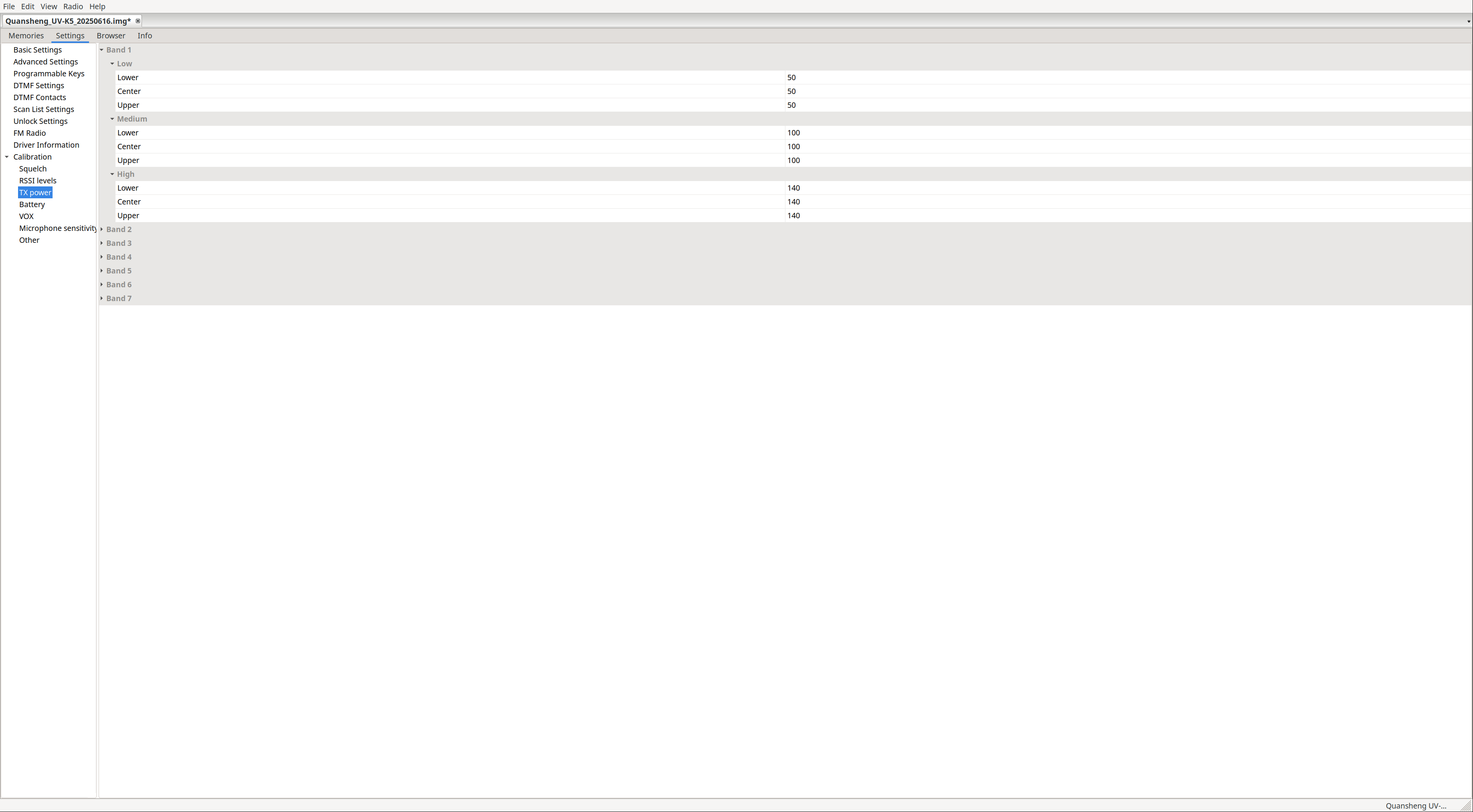
Calibration-Battery:
Only level 3 is used.
This value is configured through the
battery calibration procedure.
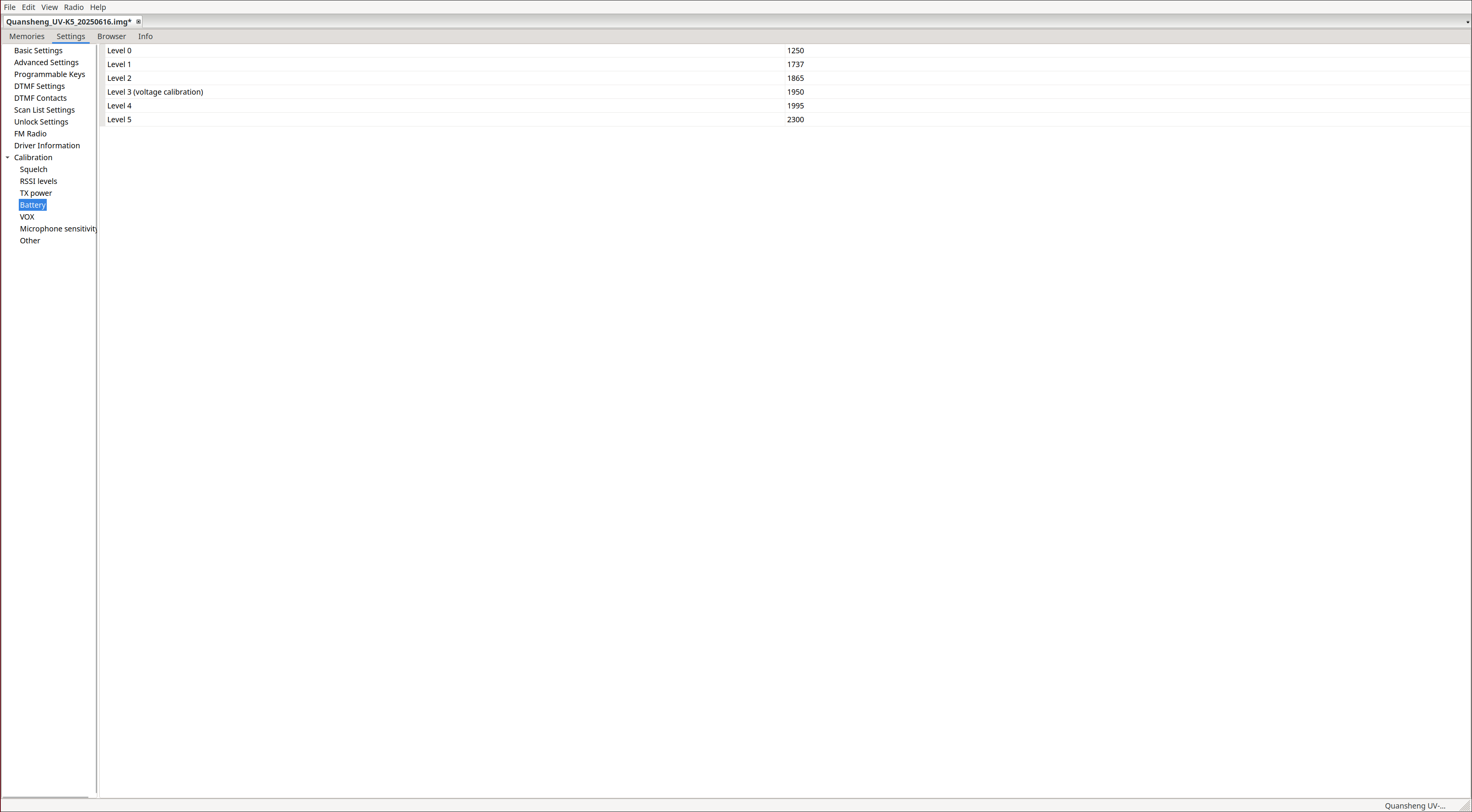
Calibration-VOX: Allows defining activation thresholds for VOX at each level.

Calibration-Microphone sensitivity:
Not used.
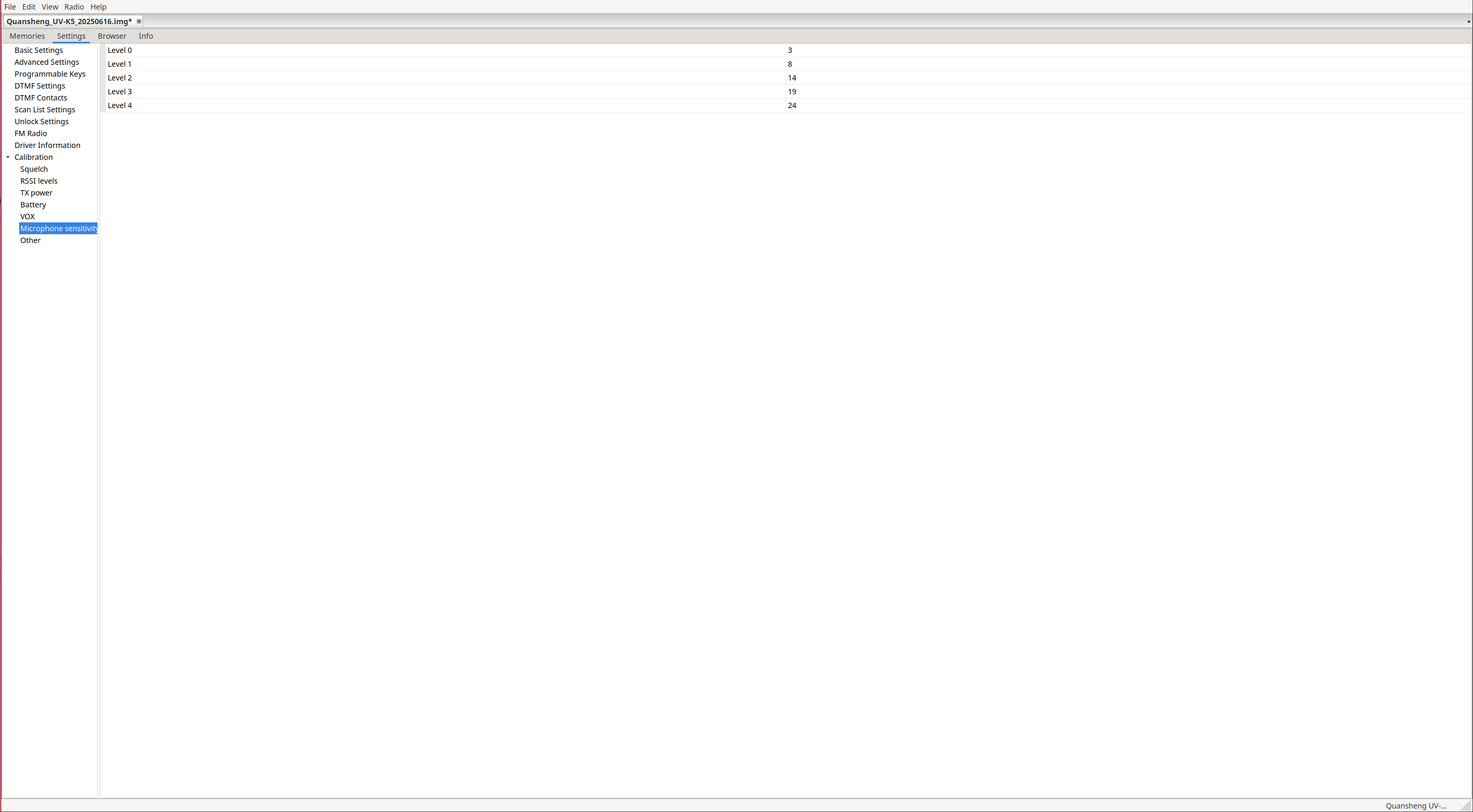
Calibration-Other: Configuration of crystal frequency and gain of volume and DAC.
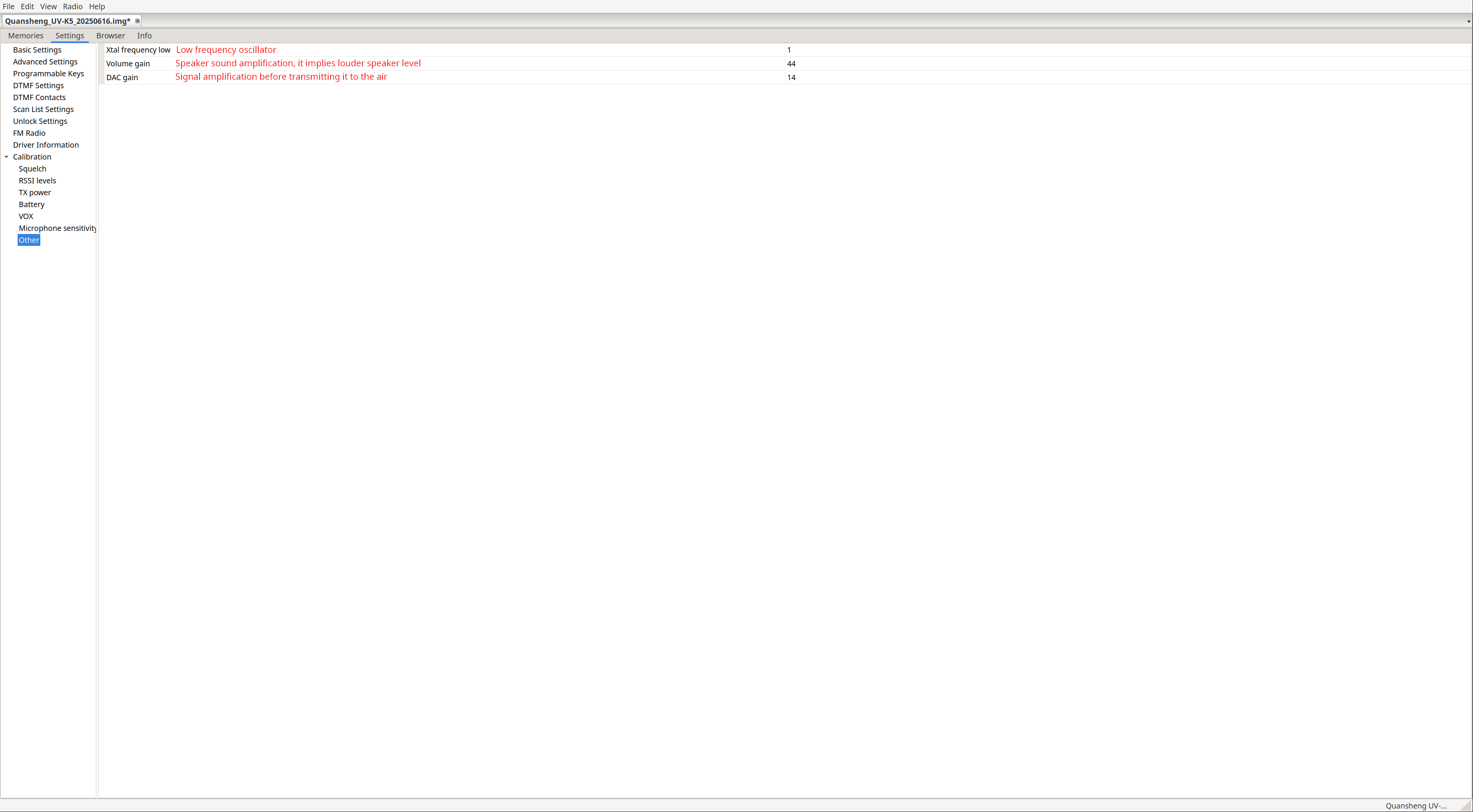
According to the radio chip datasheet , the walkie comes with a 26MHz crystal and there is a variable capacitor used for crystal frequency calibration:
Cvar is an adjustable capacitor for frequency calibration.

I imagine that a 26MHz crystal is considered low frequency and for this reason, Xtal frequency low receives a default value of 1; I don’t think this parameter needs to be touched unless hardware modifications are made to the walkie.
Specific Functions:
Now let’s move on to the specific functions of AubsUK firmware. Some of these were already explored in the
functions section
. Features in bold indicate additional functionalities compared to the
stock firmware
, and those underlined are additional compared to
EGZUMER’s firmware
.
Adding a channel to a scan list:
In
channel mode
, access the menu M(A) -> ScnAdd(14). Inside, you can enable or disable the channel in different scan lists using the numeric buttons.
In this video, channels Test1/2 are added to scanlist8, and Test3/4 to scanlist9:
In CHIRP, manage this via Memories -> Scanlists:

Scan lists scanning:
To scan lists, hold down the *(Scan) button while in
channel mode
. The top display shows the scan lists enabled (0-9).
To enable/disable lists, press the number key corresponding to the list. Depending on the scan and list status, the display shows:
- Number: List enabled and currently being scanned.
- *: List enabled but not currently scanned.
- -: List disabled.
The LED indicates your action:
- Green: Scan list enabled.
- Red: Scan list disabled.
This video shows enabling/disabling scan lists:
In CHIRP, configure via Settings -> Scan List Settings:
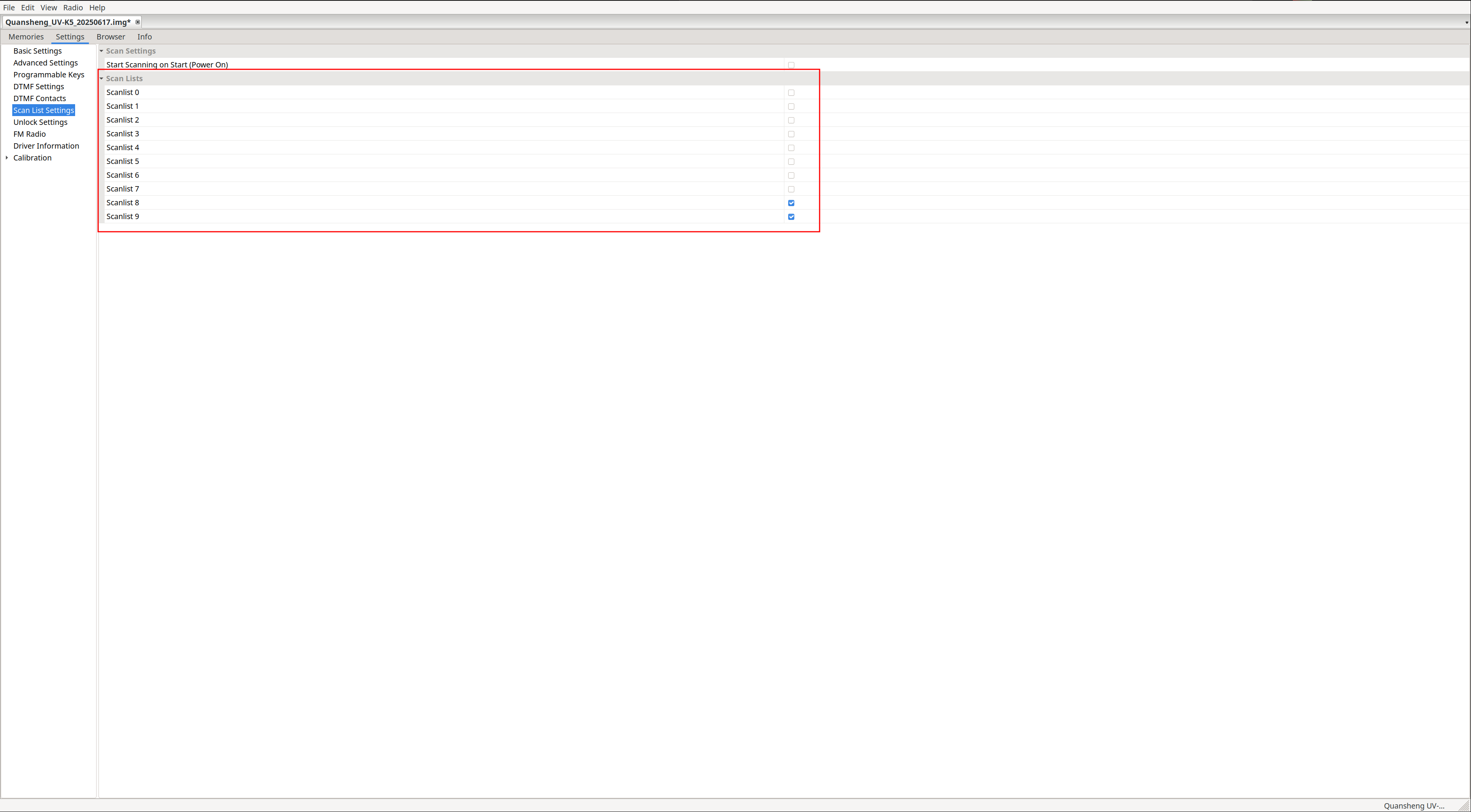
Lockouts:
Channels can be excluded from scans in two ways.
Permanent exclusion:
To permanently exclude a channel from scanning, go to menu M(A) -> ScnLkO(15):
In CHIRP, access Memories -> Skip:
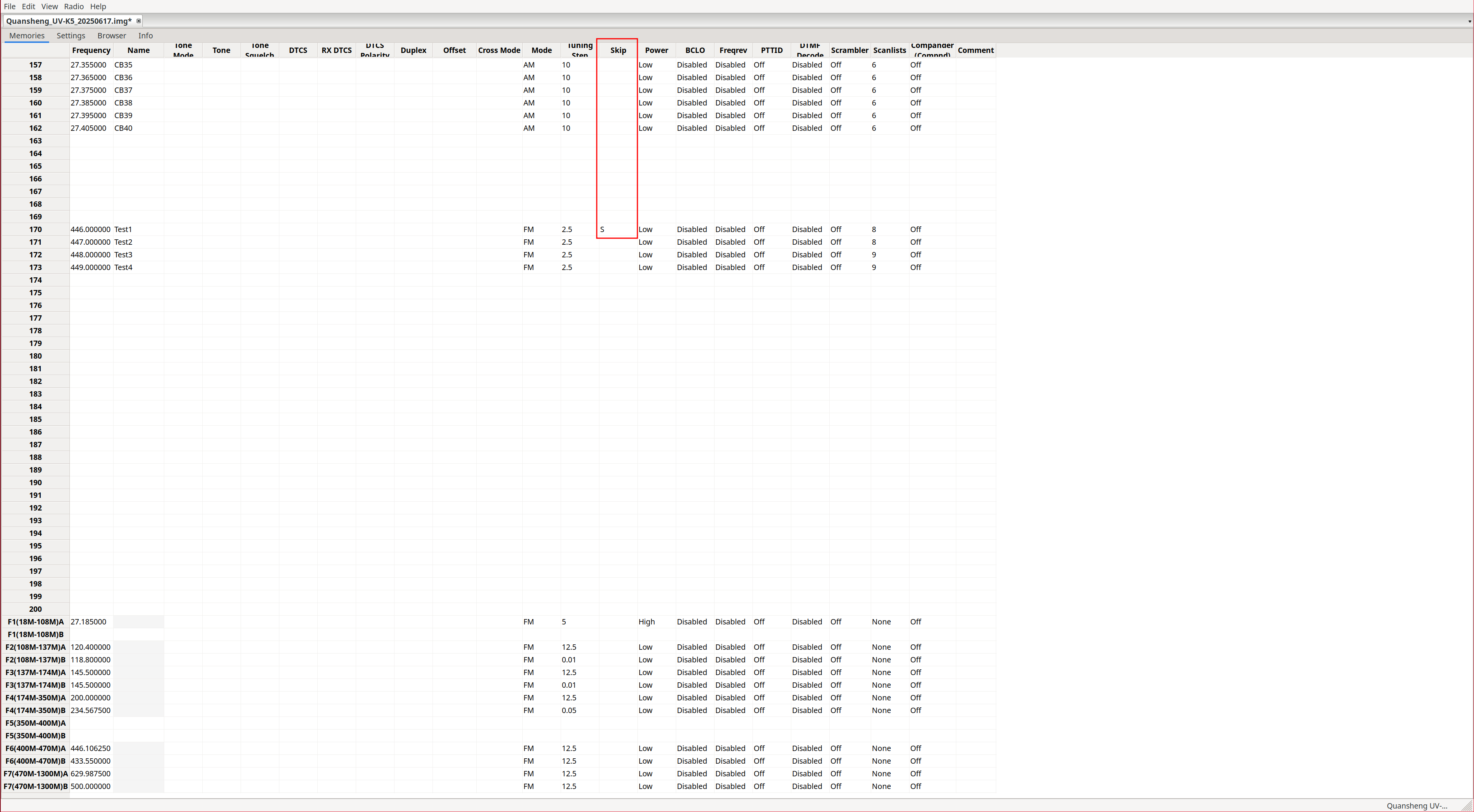
Temporary exclusion:
You can temporarily exclude a channel from scanning until the next radio reboot — useful if a busy channel constantly interrupts scanning. Press *(Scan); the LED blinks red twice and the channel is excluded.
Temporary exclusions cannot be managed from CHIRP because it requires rebooting the radio after loading settings.
Scan on start:
This firmware supports automatic scanning on power-up. Behavior depends on the mode the radio was in when powered off:
- Channel mode : resumes scanning as it was last used.
- VFO mode : scans from the last VFO frequency.
Enable this in menu M(A) -> ScnSrt(16):
In CHIRP, use Settings -> Scan List Settings:
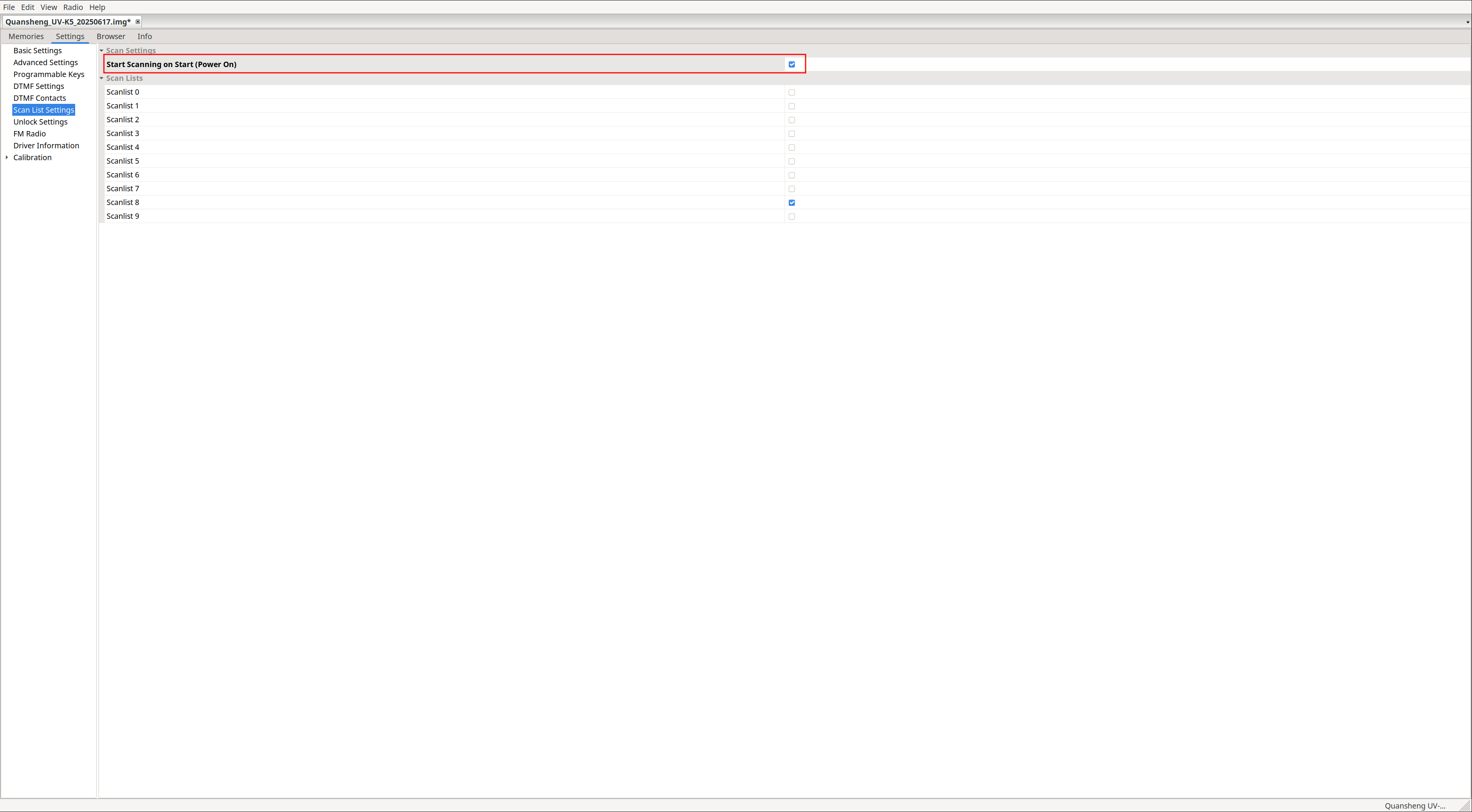
ScanList members:
To see which channels belong to each scan list, go to menu M(A) -> SLists(17). Press the list number to jump directly to its members:
In CHIRP, just view Memories -> Scanlists:
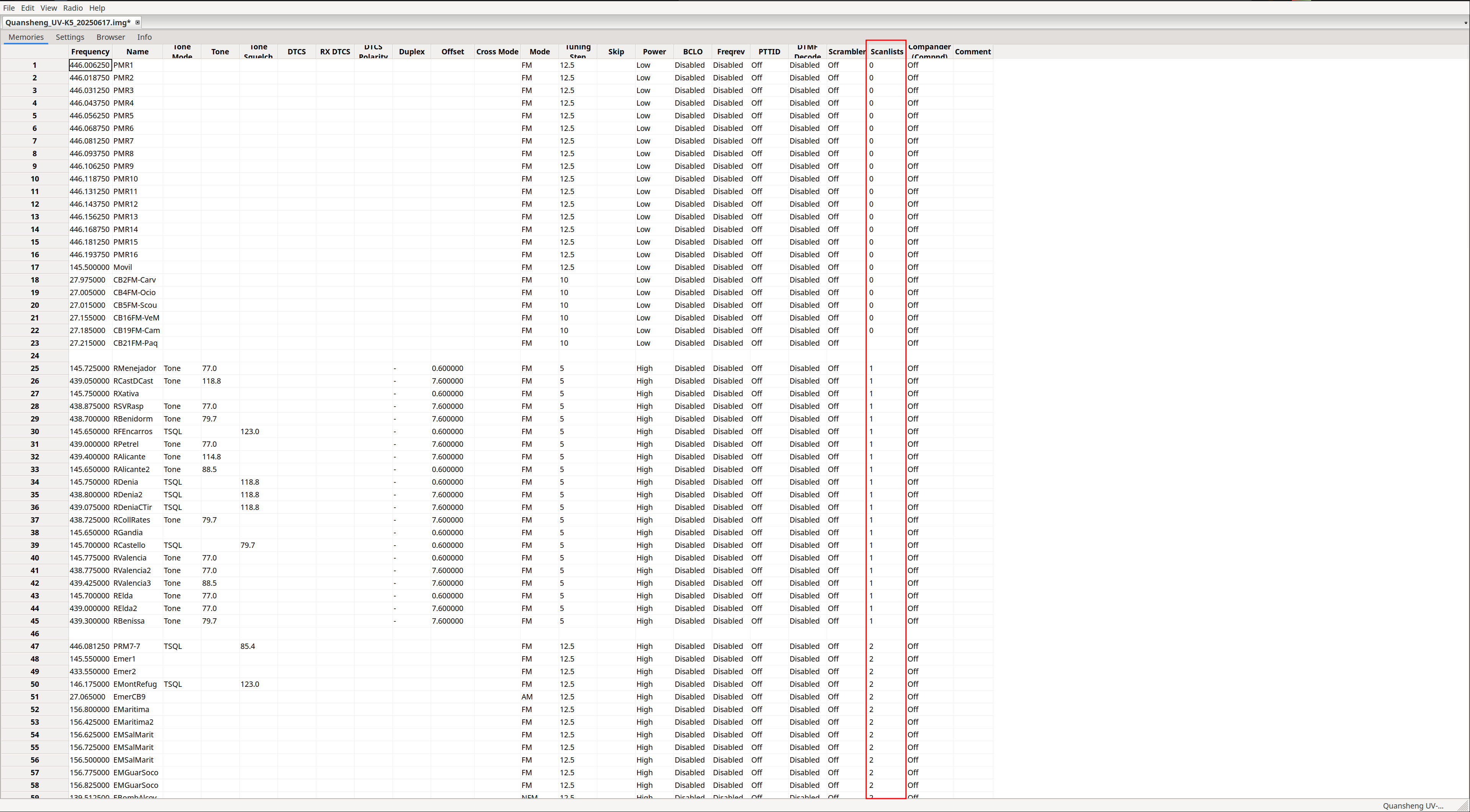
Bugs:
This firmware has some bugs to keep in mind:
- DTMF calls between different firmware versions have issues, detailed in the DTMF calls section .
- The kill code feature appears completely broken, see Remote kill section .
Additionally, CHIRP currently has many bugs with this radio model — for example, channel 25 shows only one analog output tone configured, but in Properties digital tones and others appear:
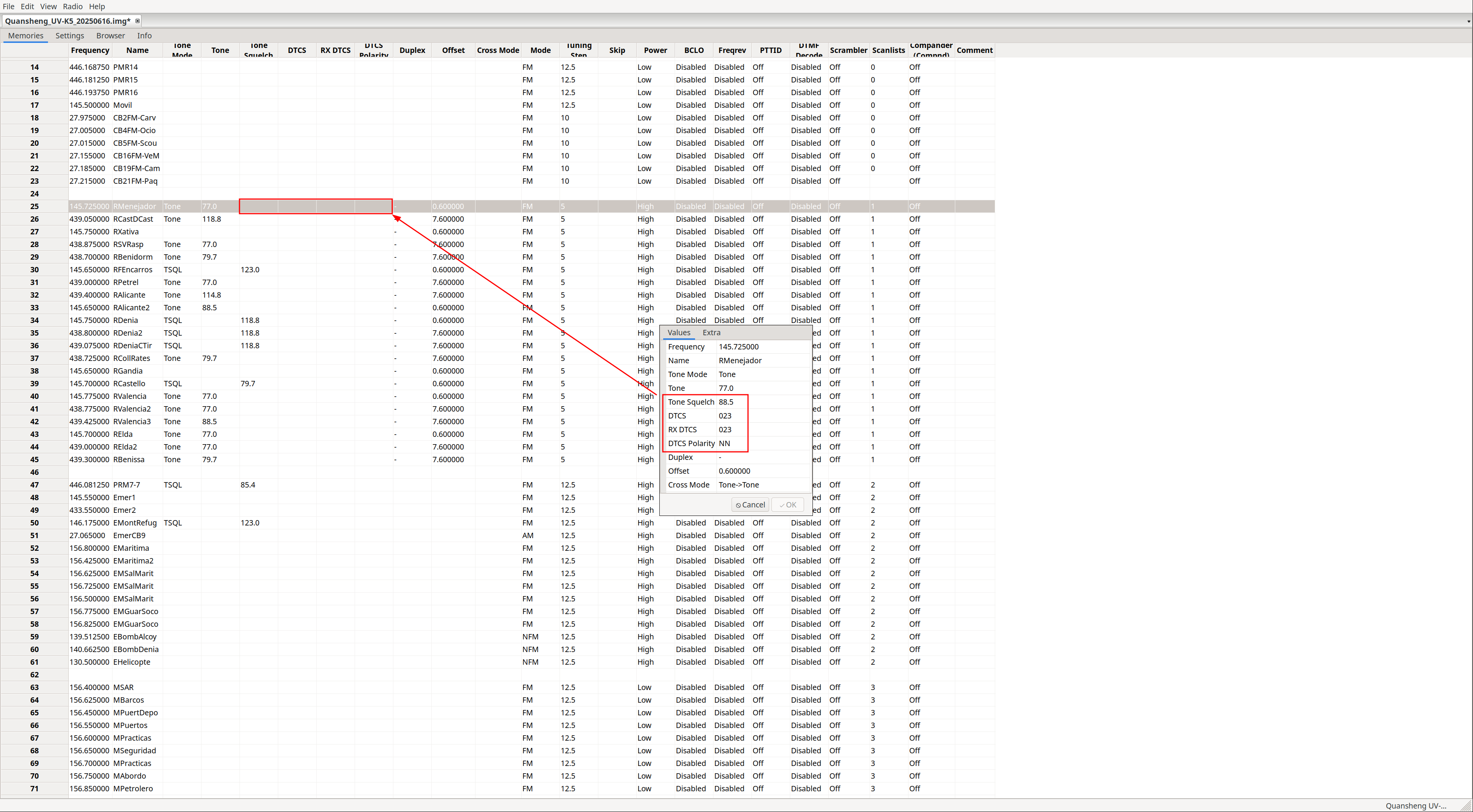
As a final note, thanks to my friend Manhattan for kindly lending me his radio to perform all the tests in this article.